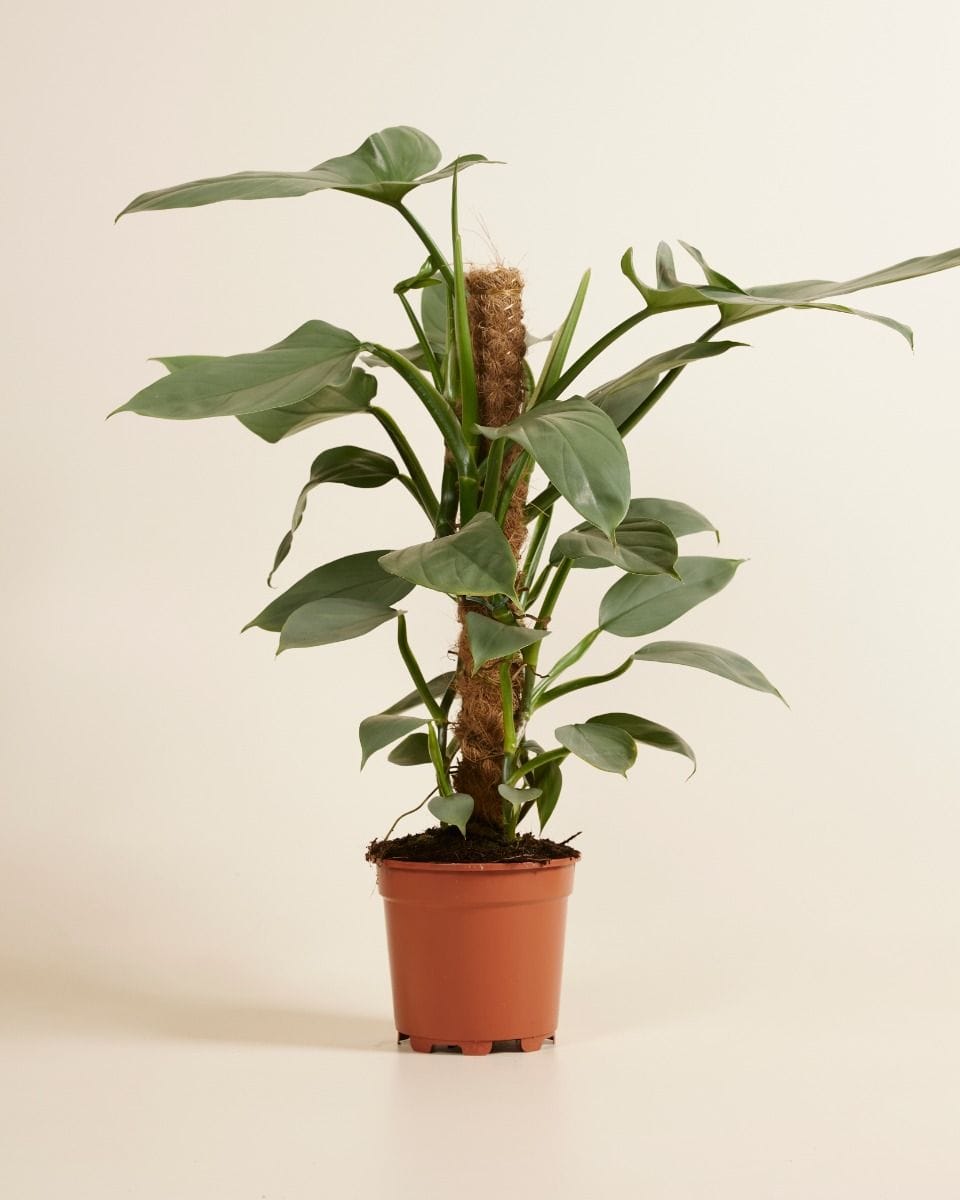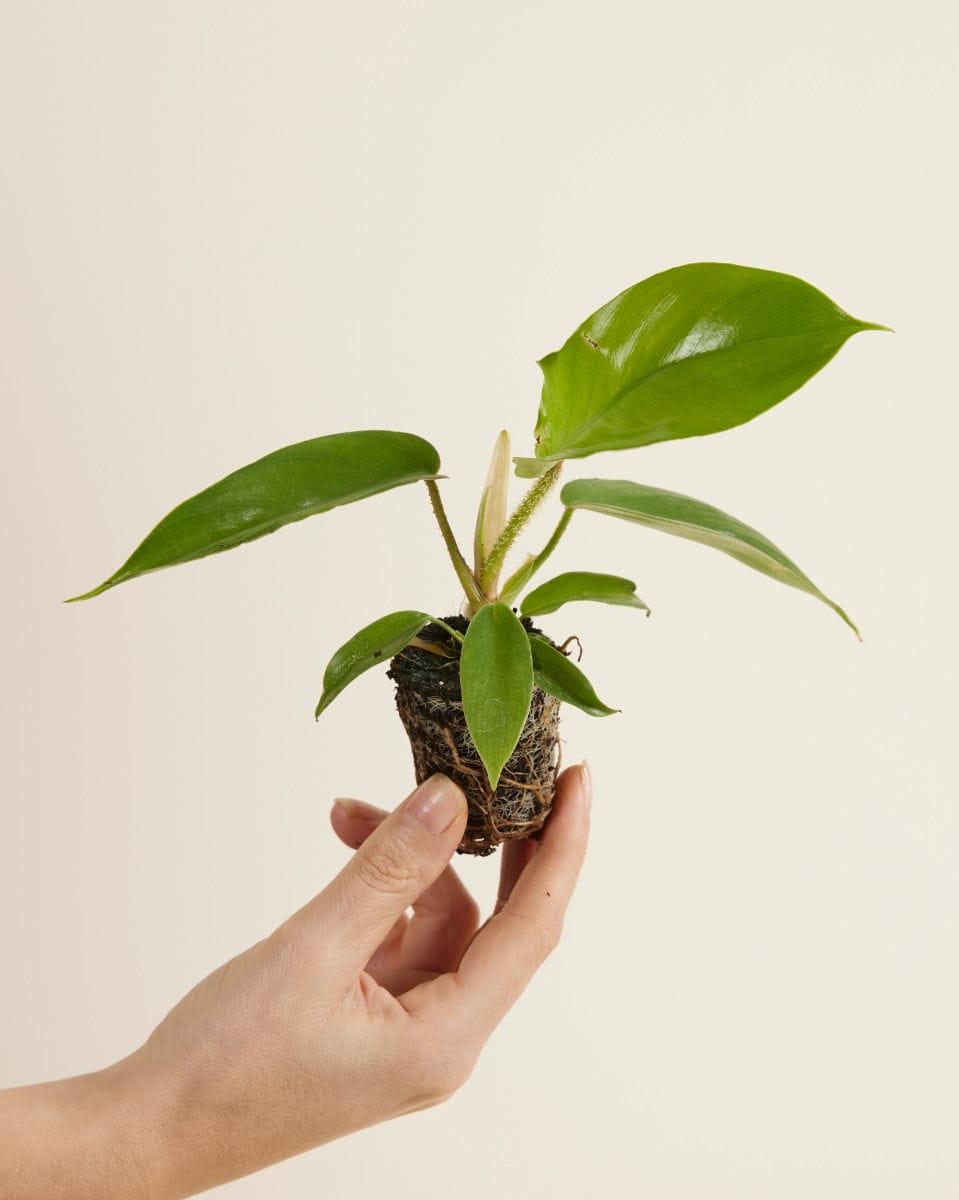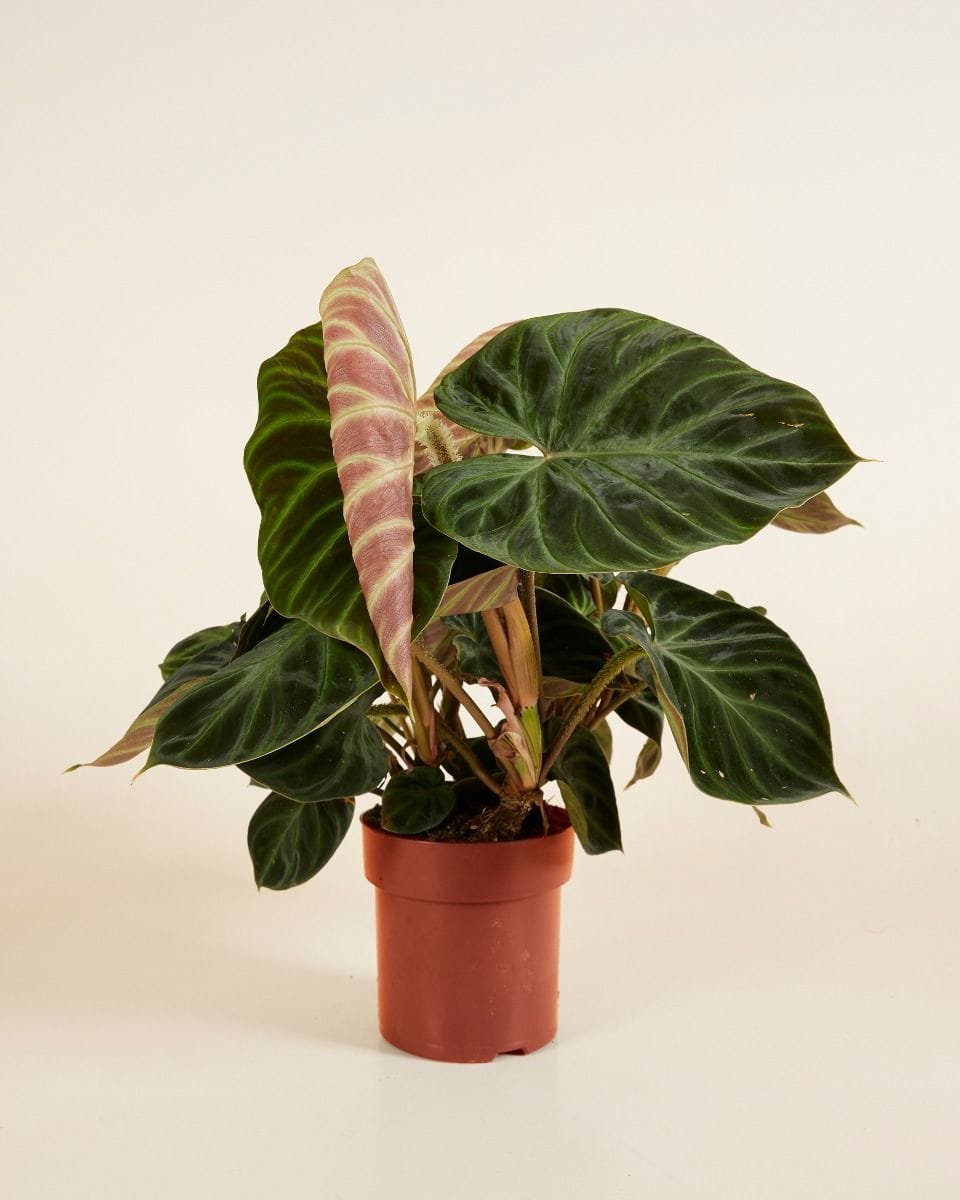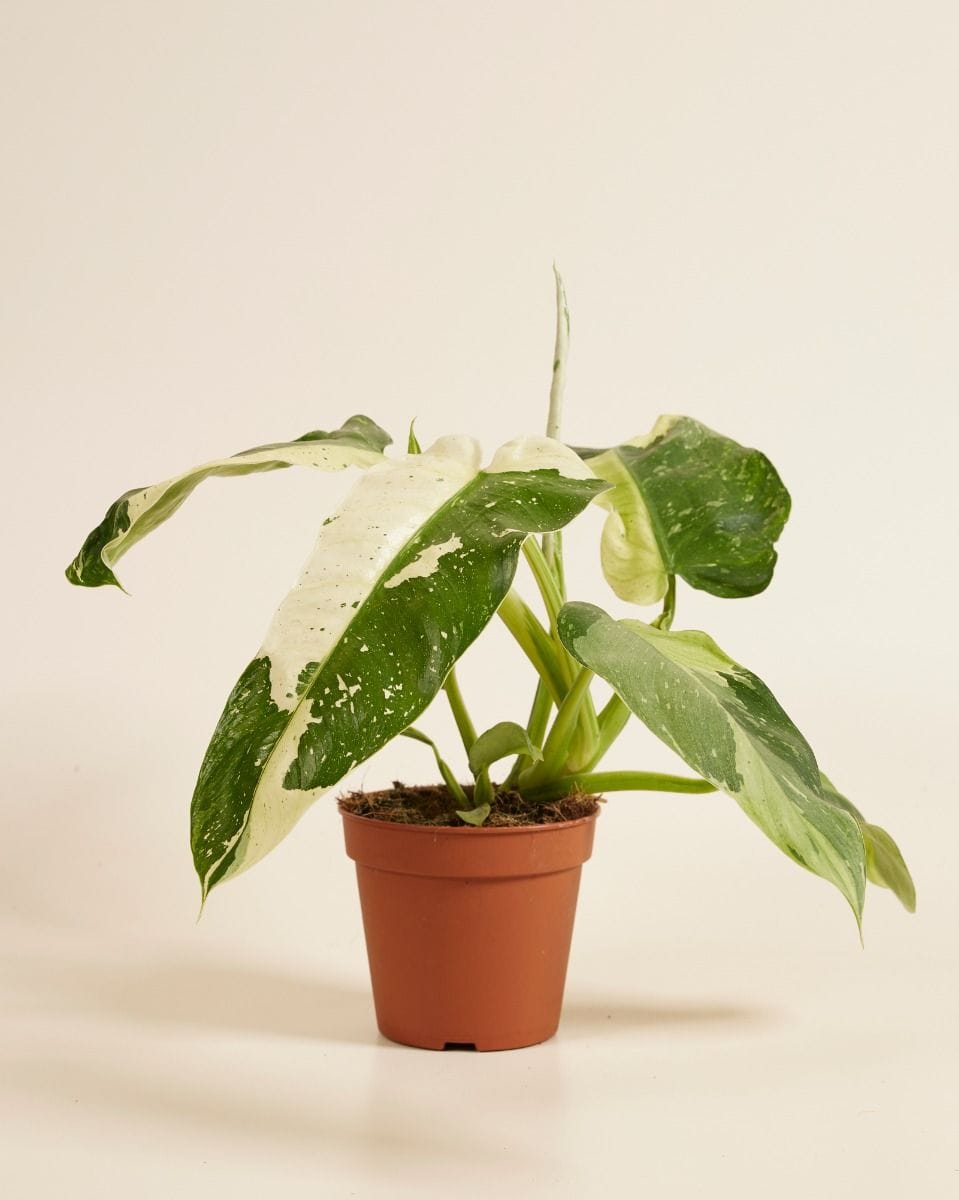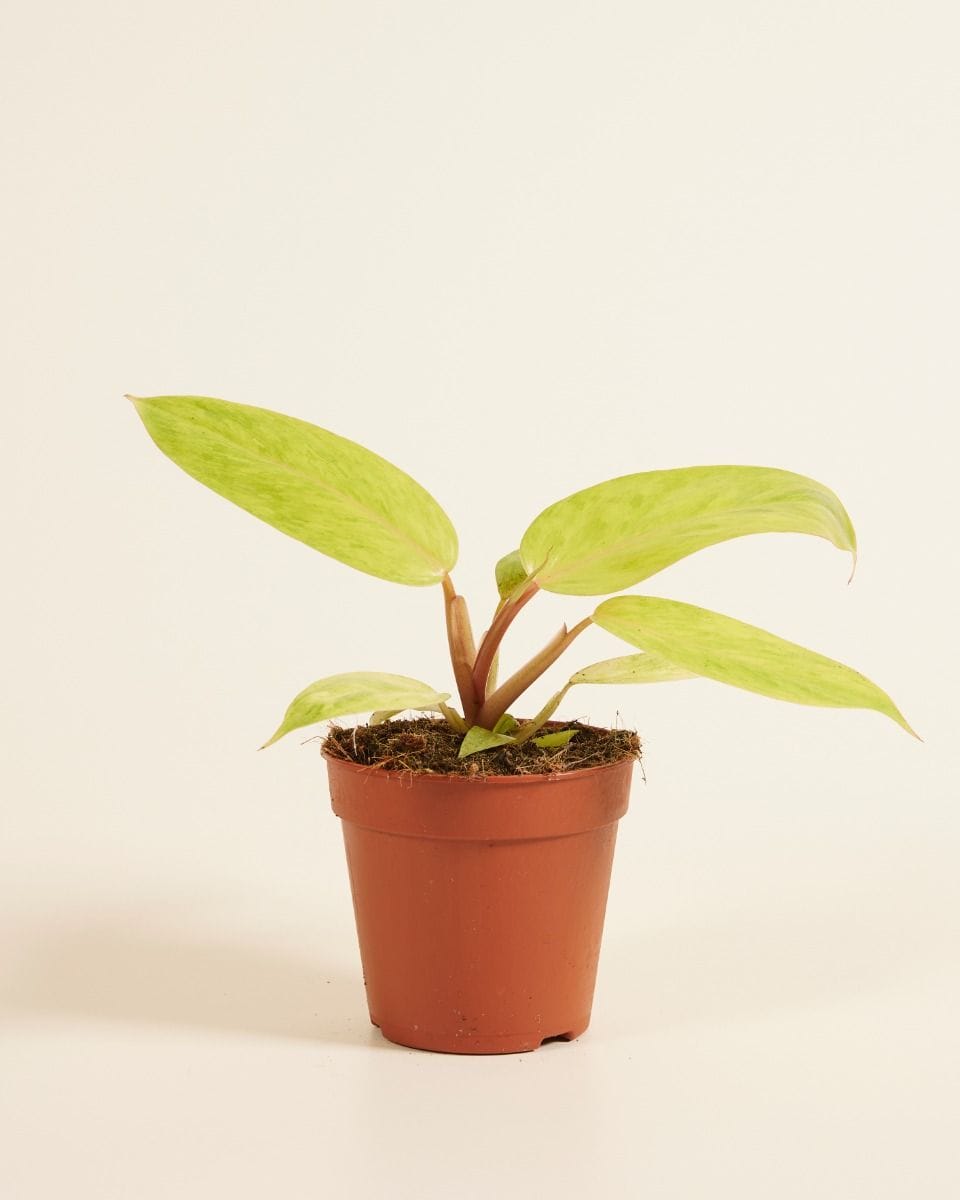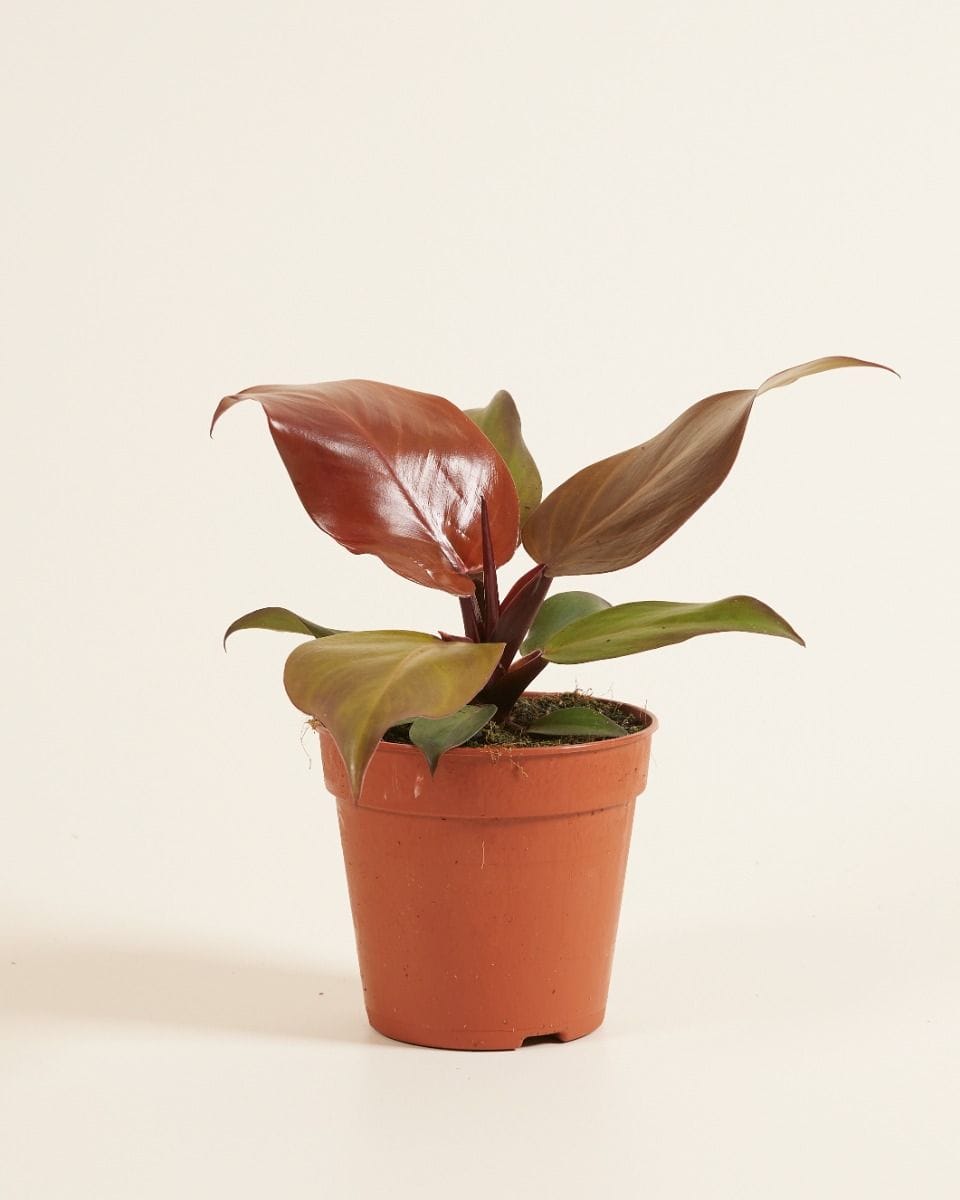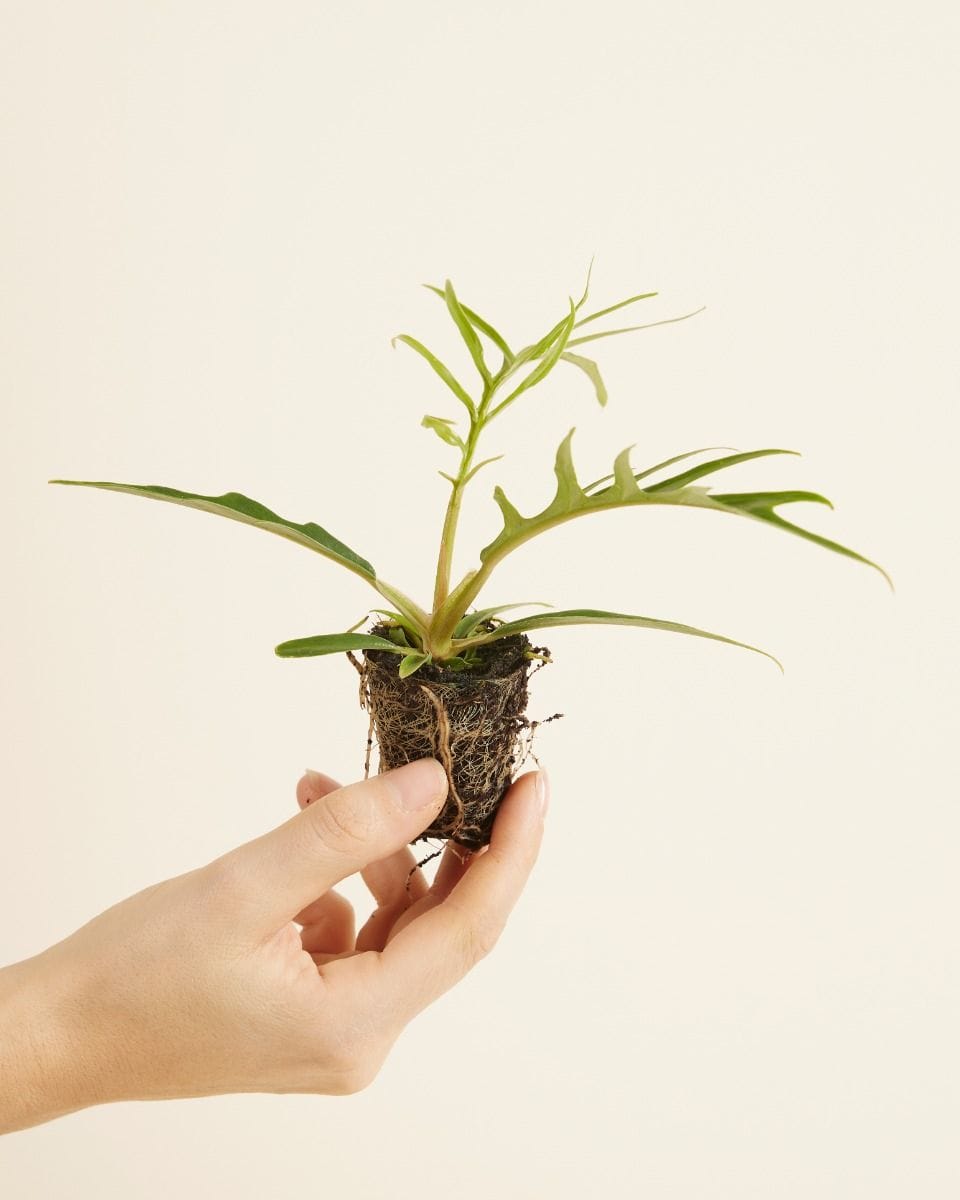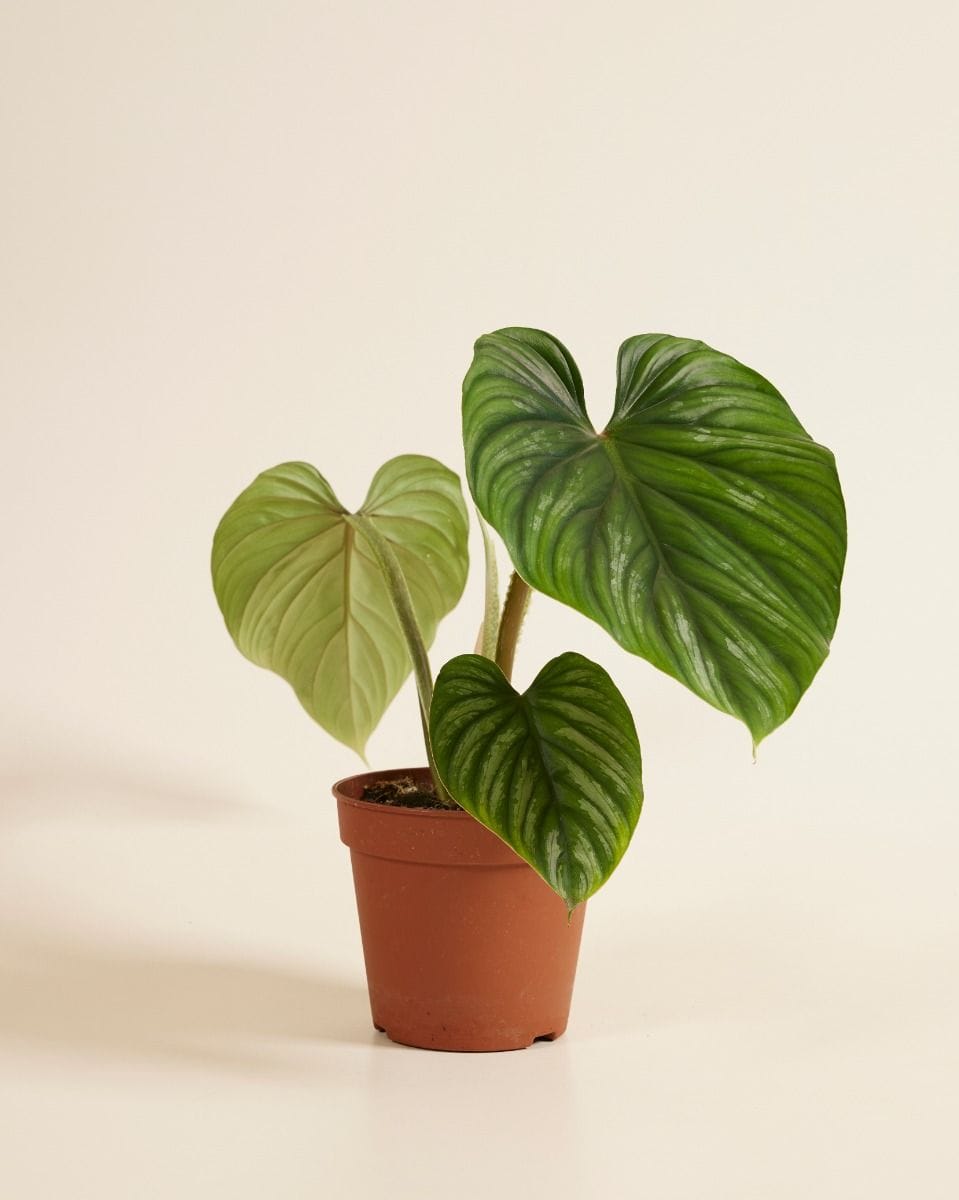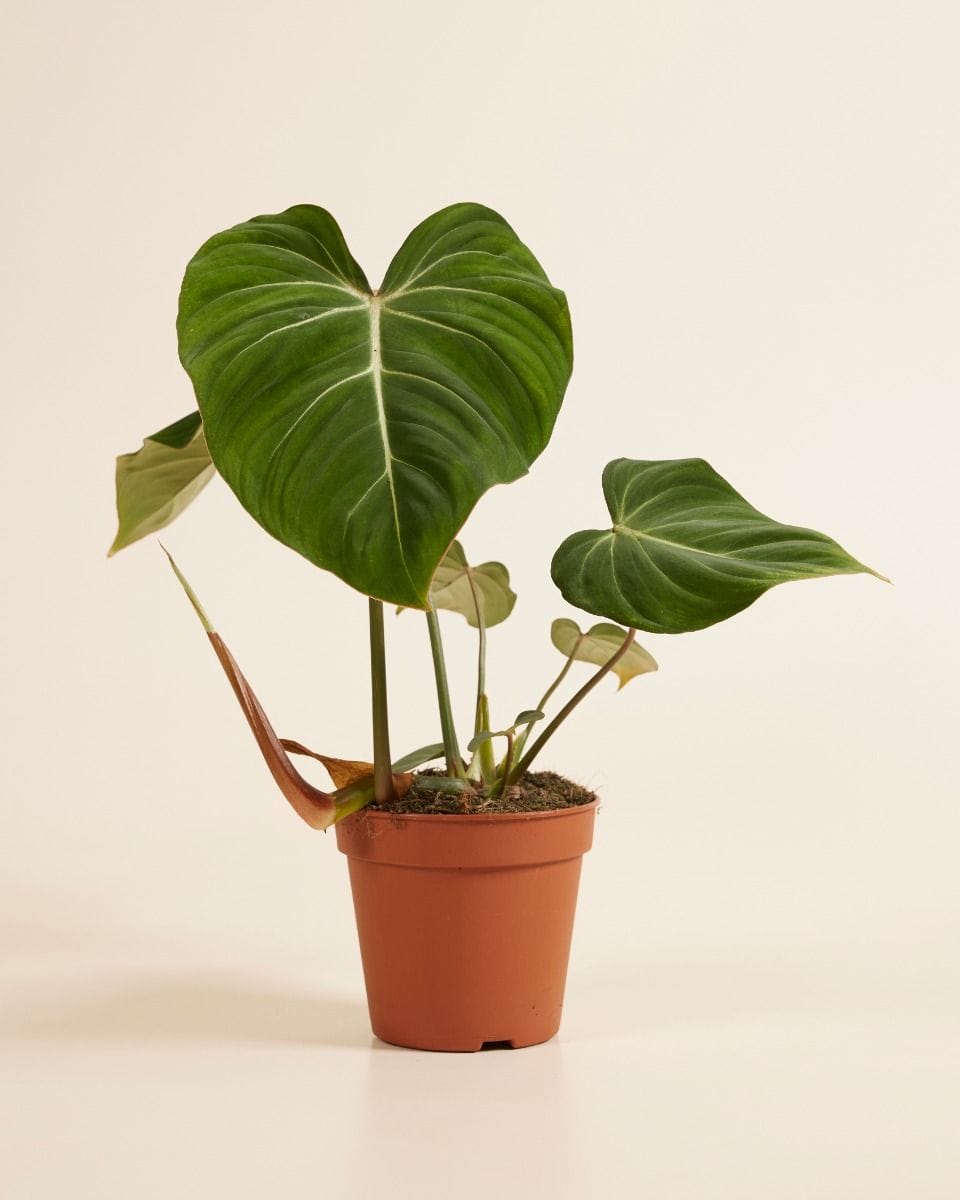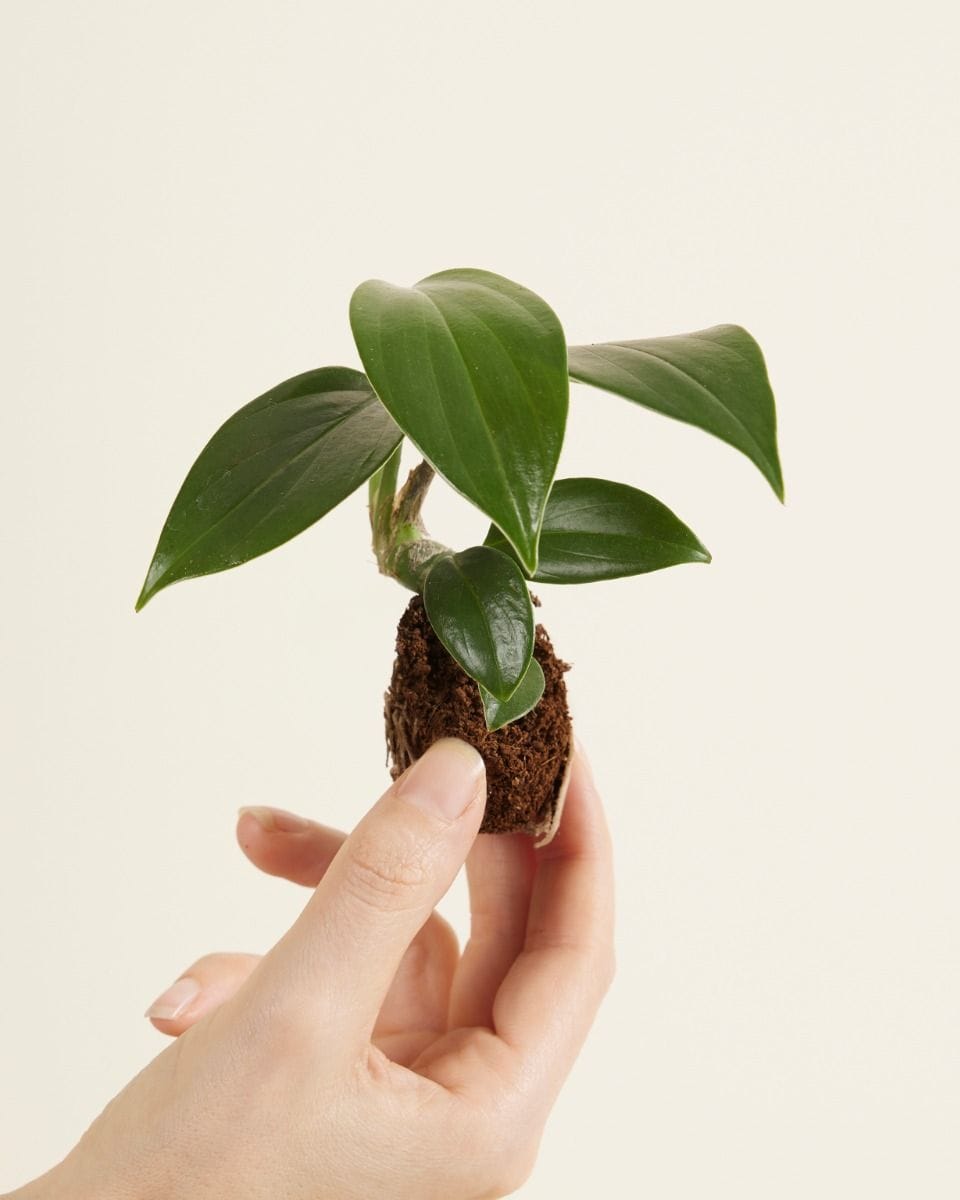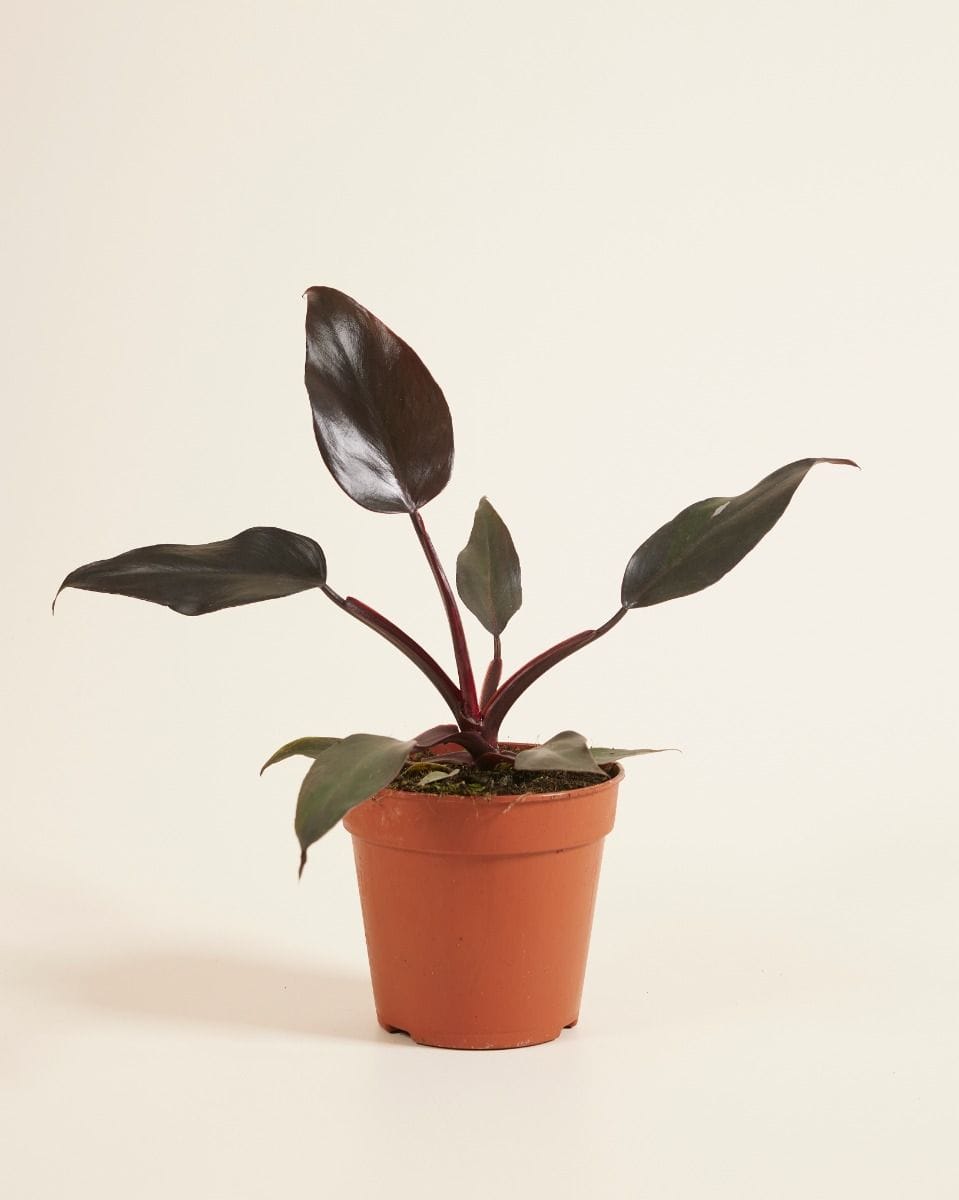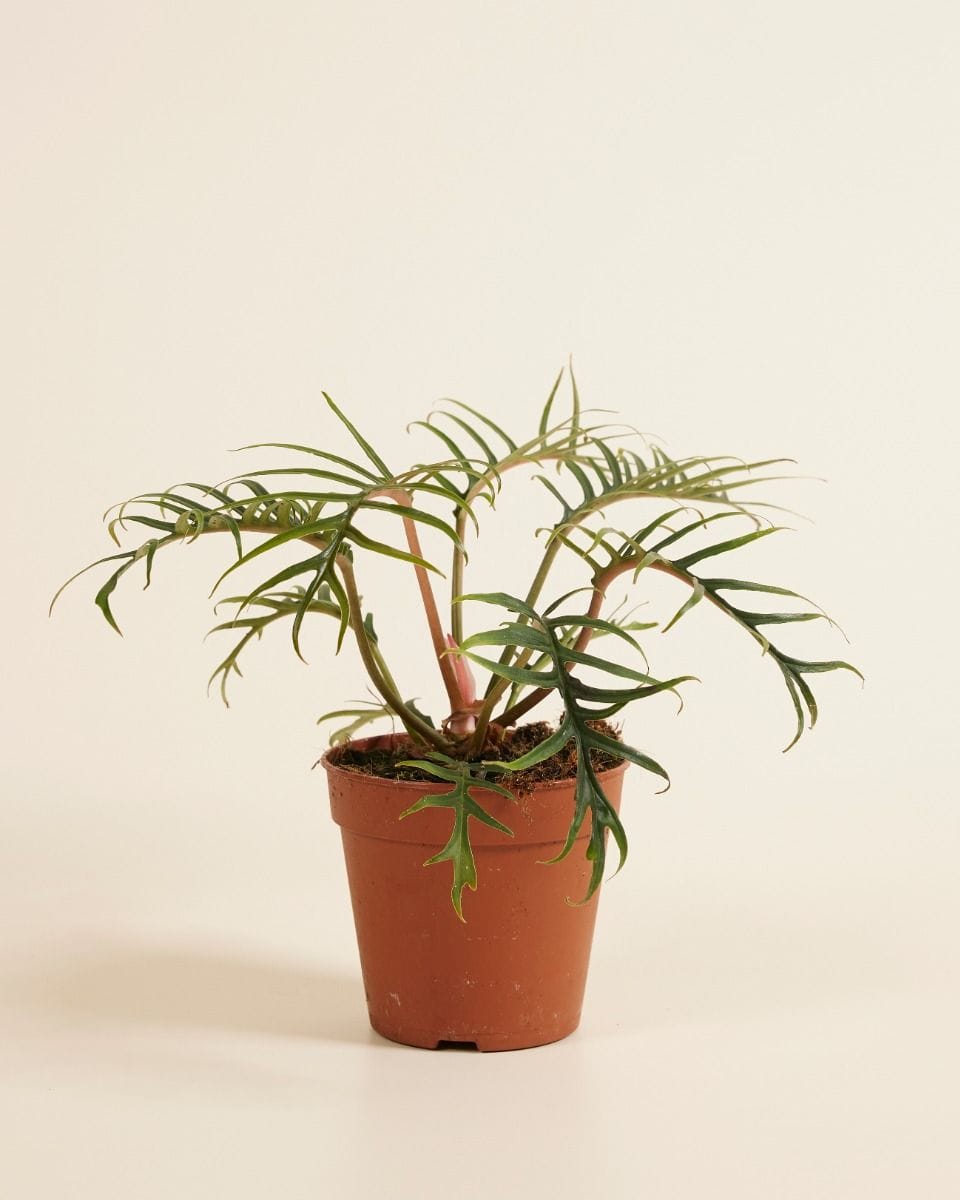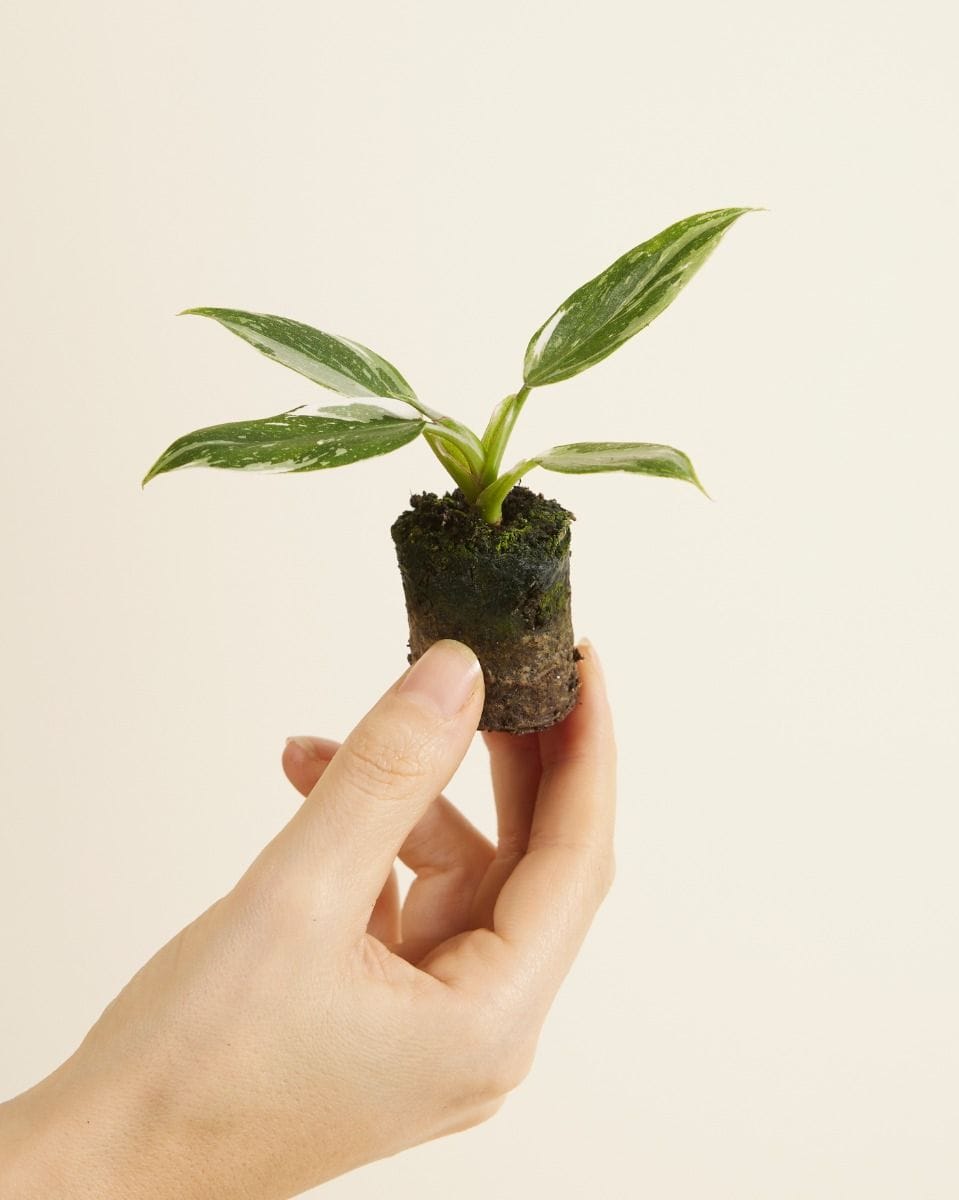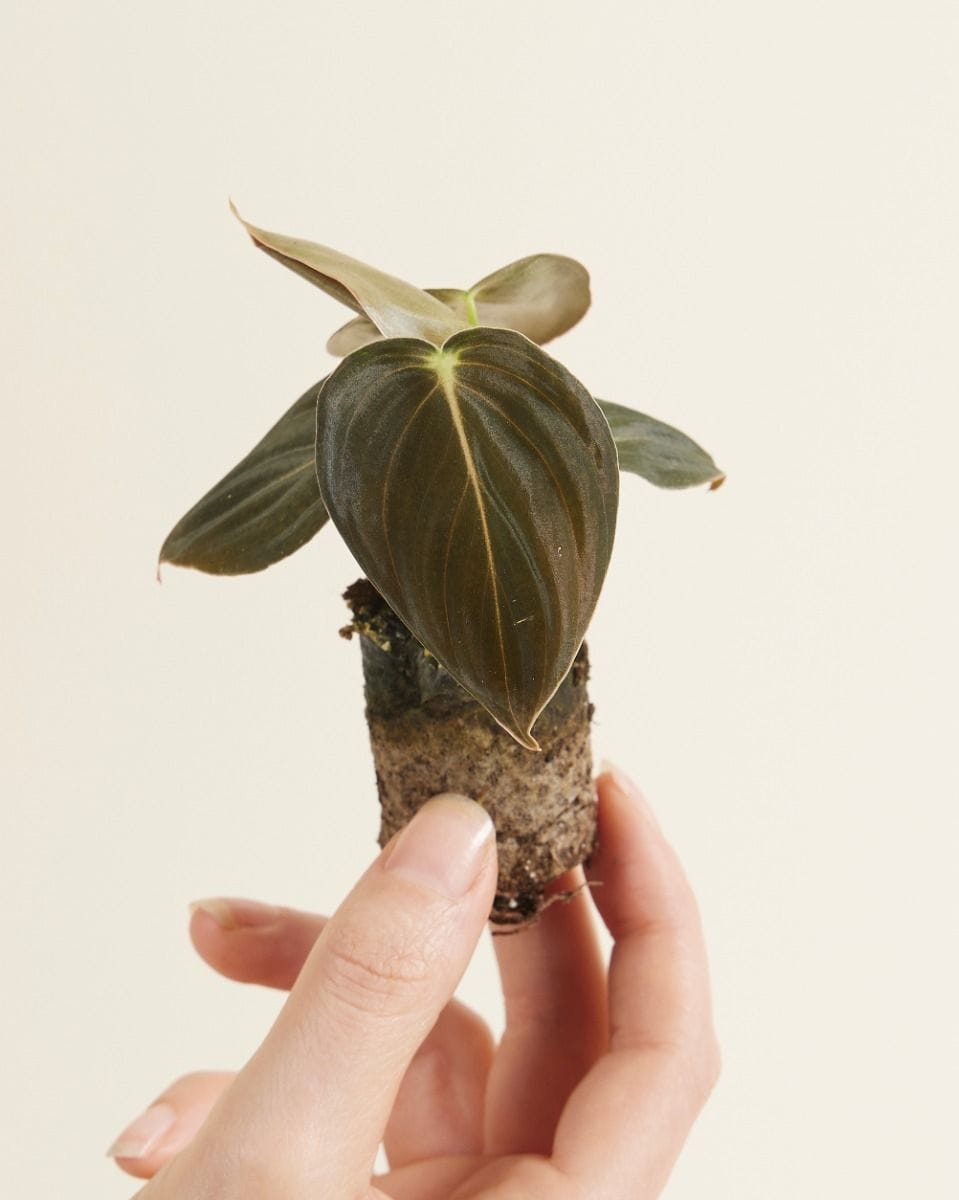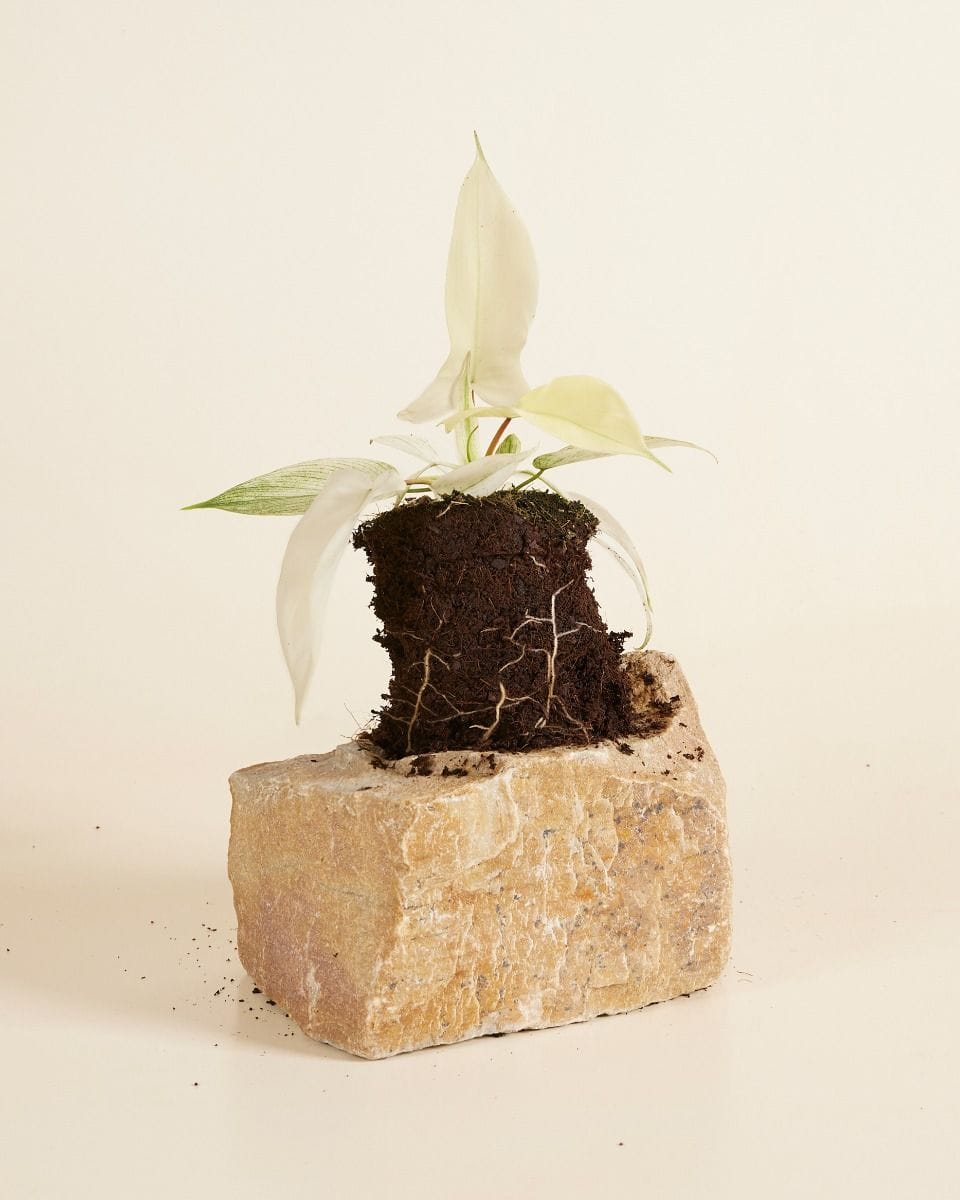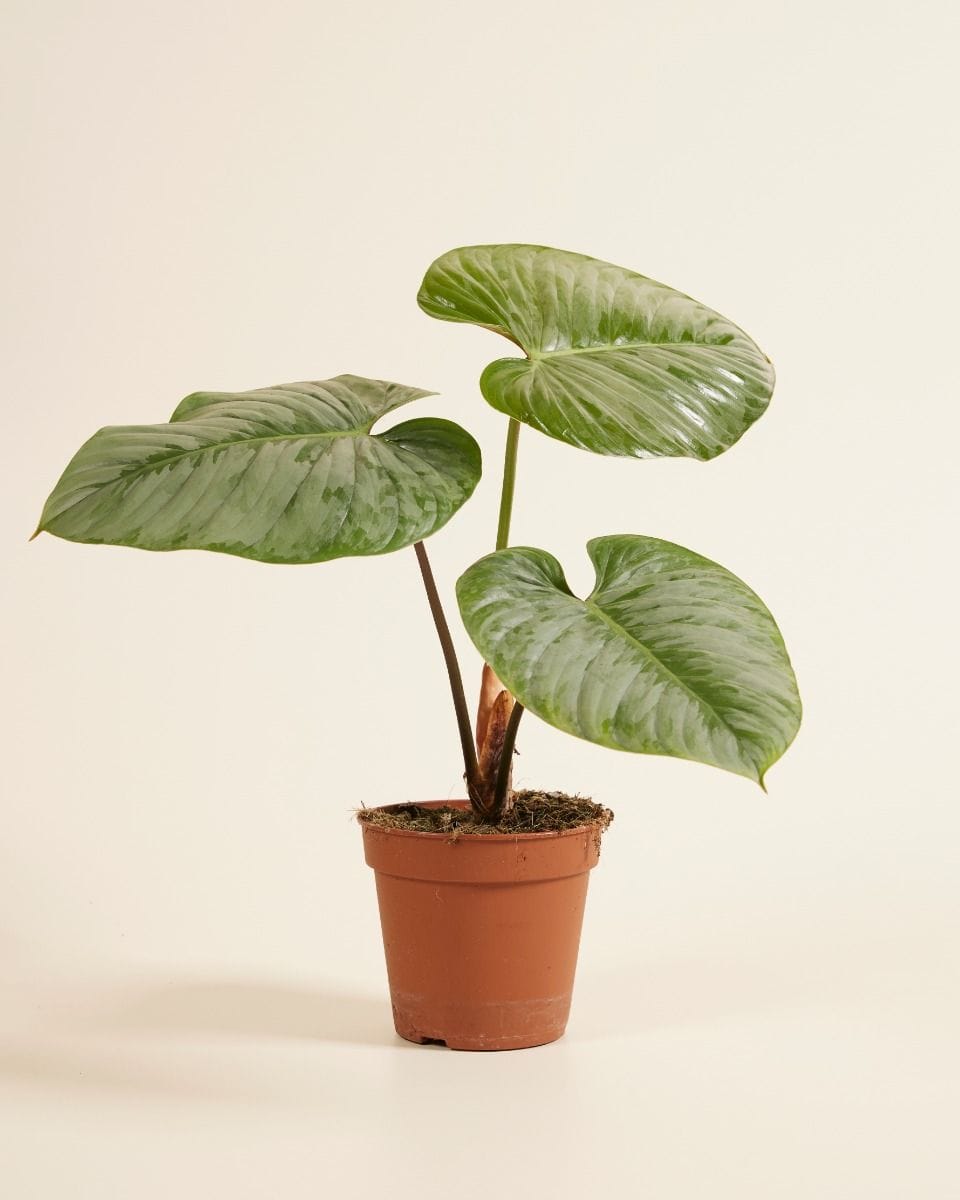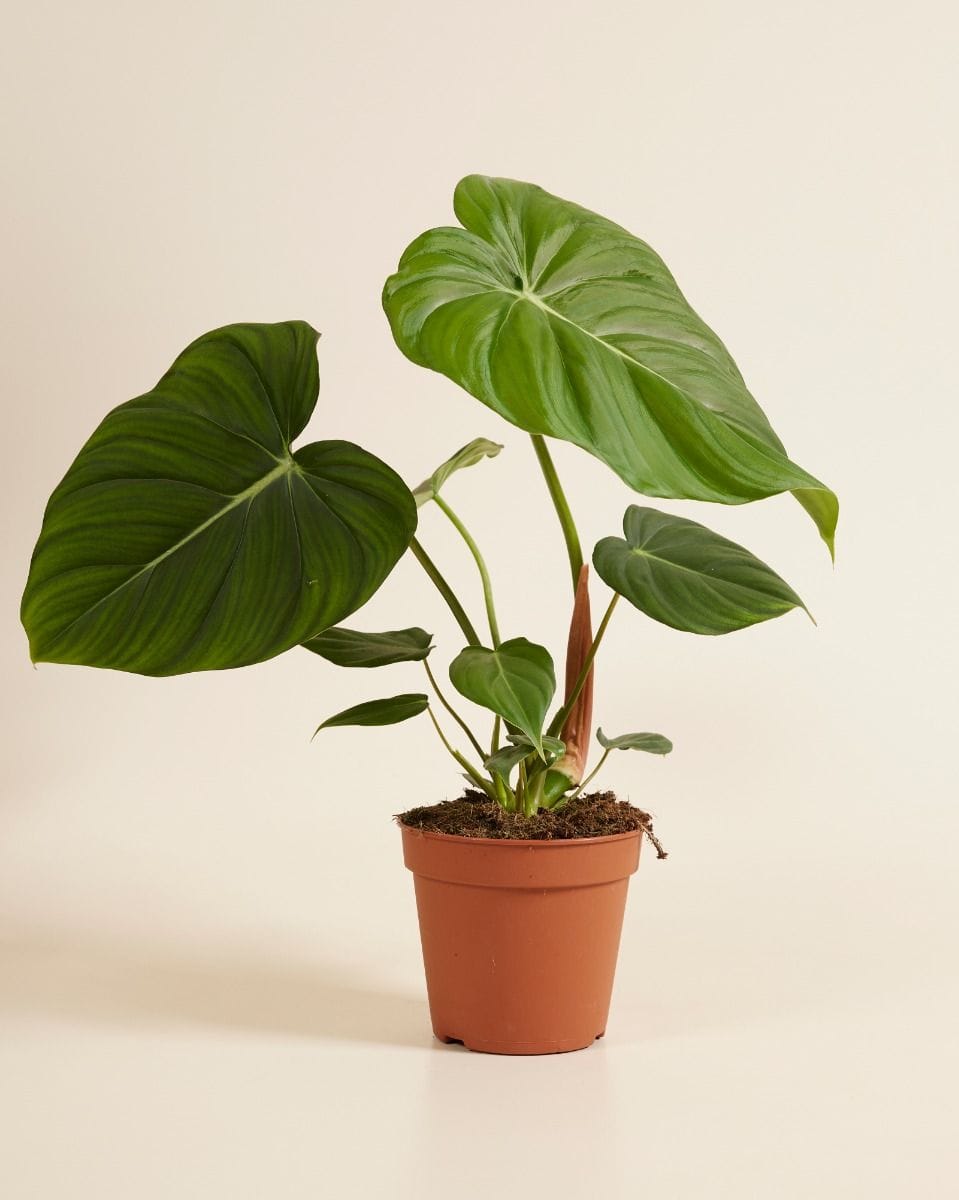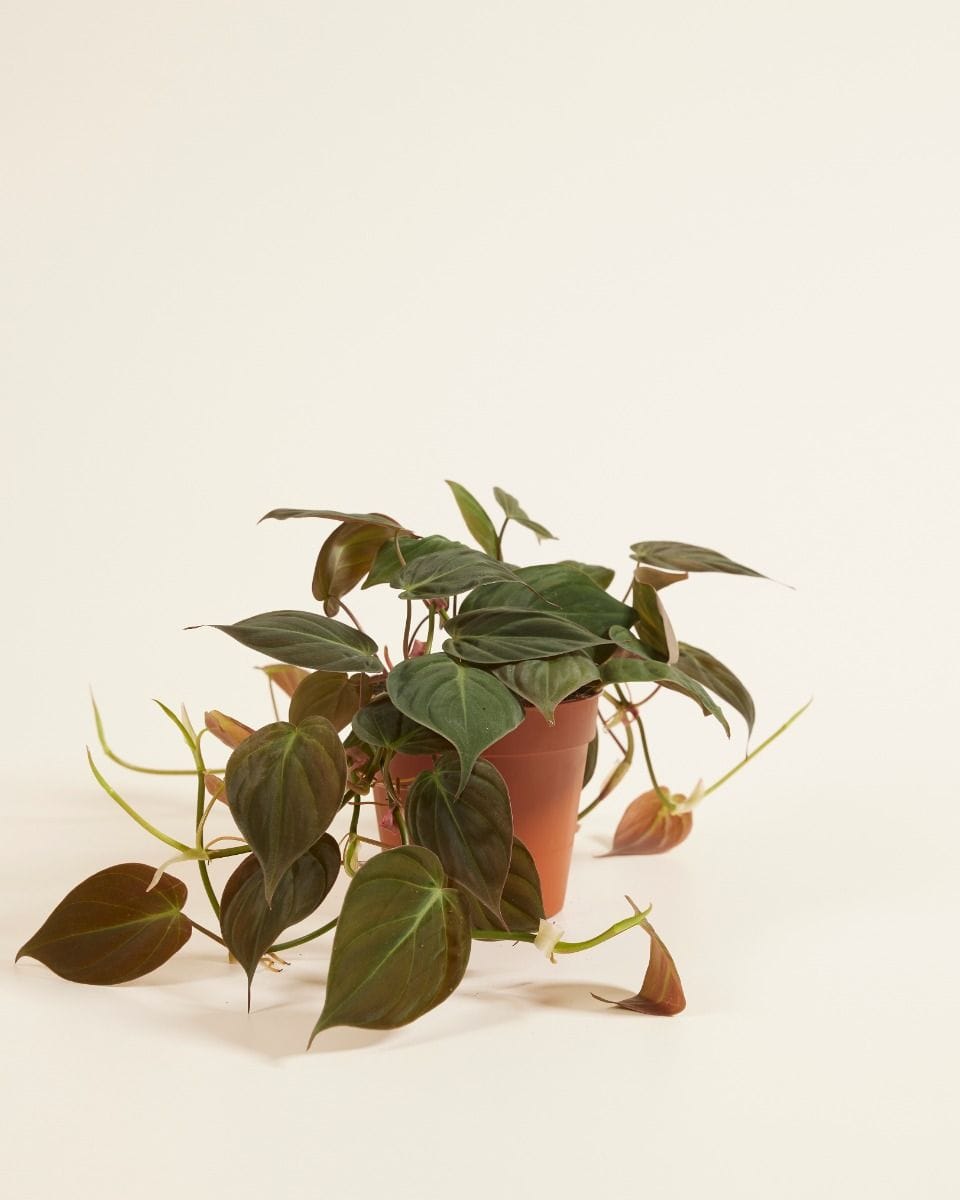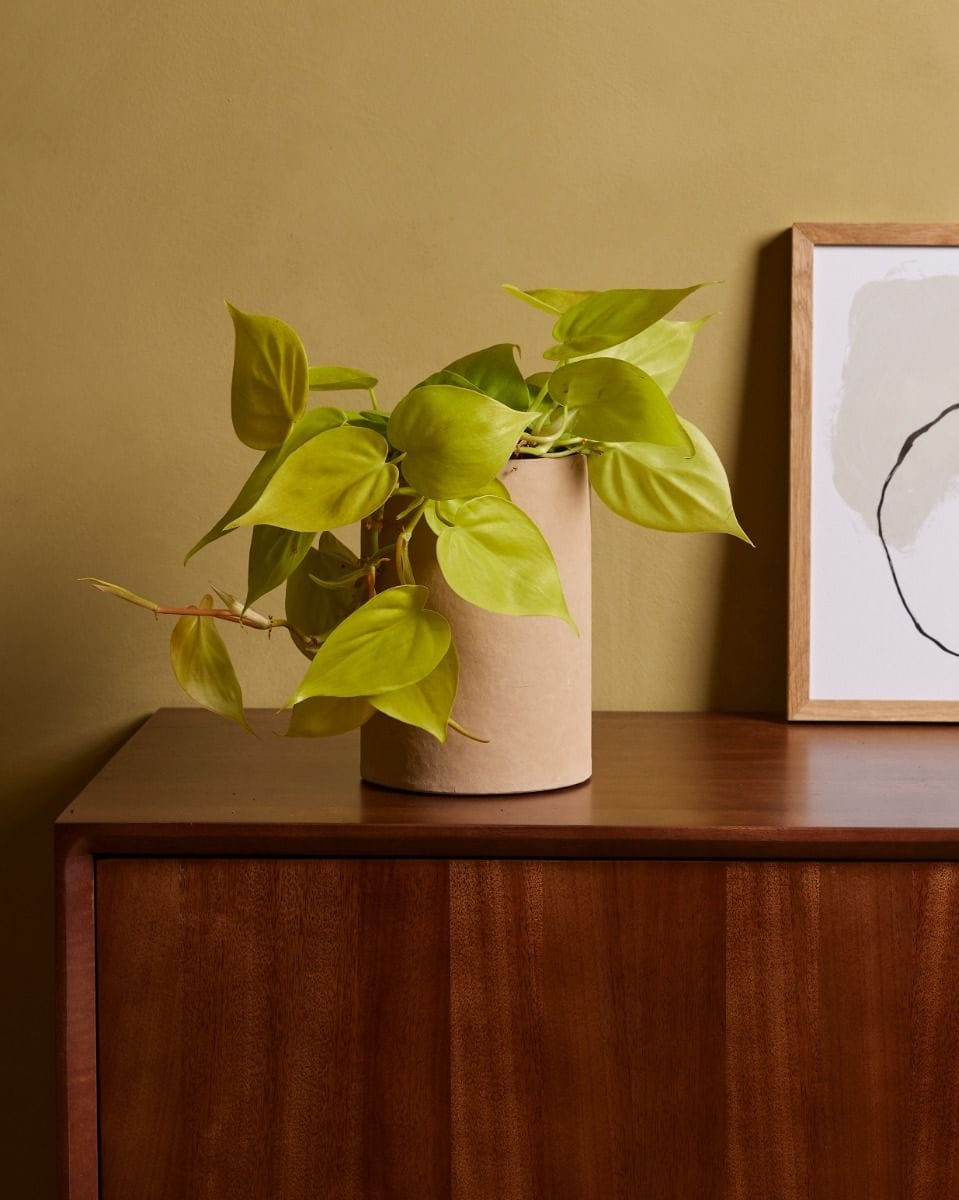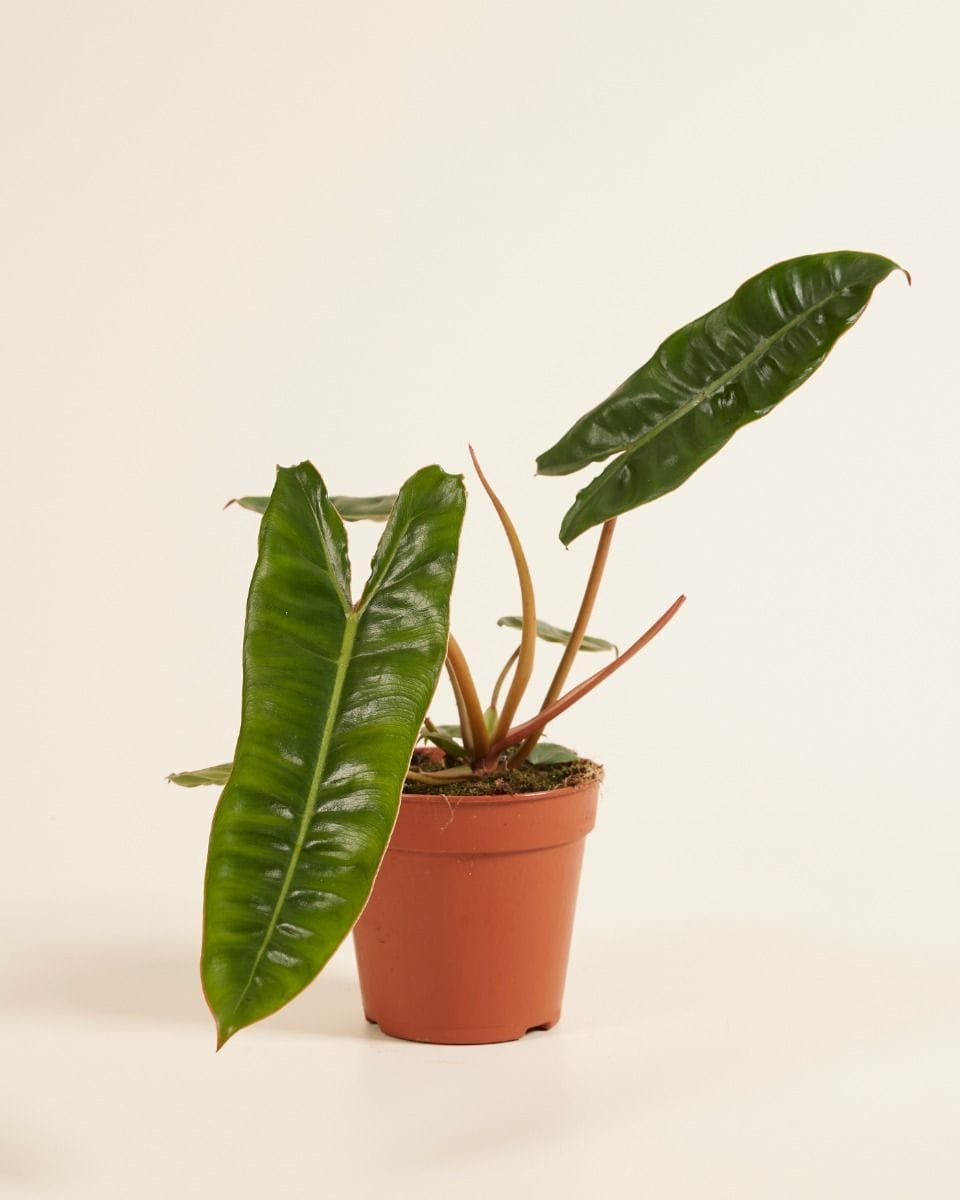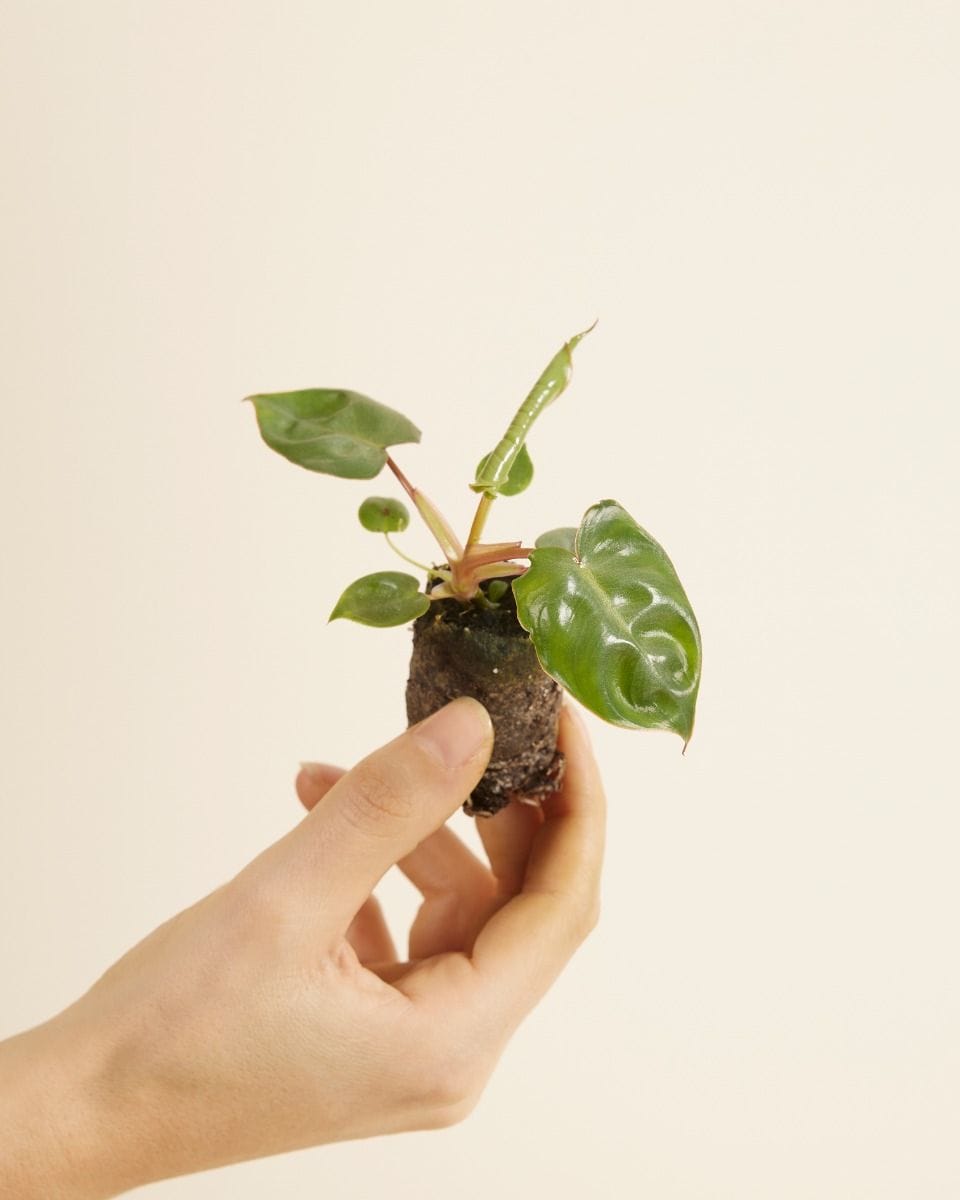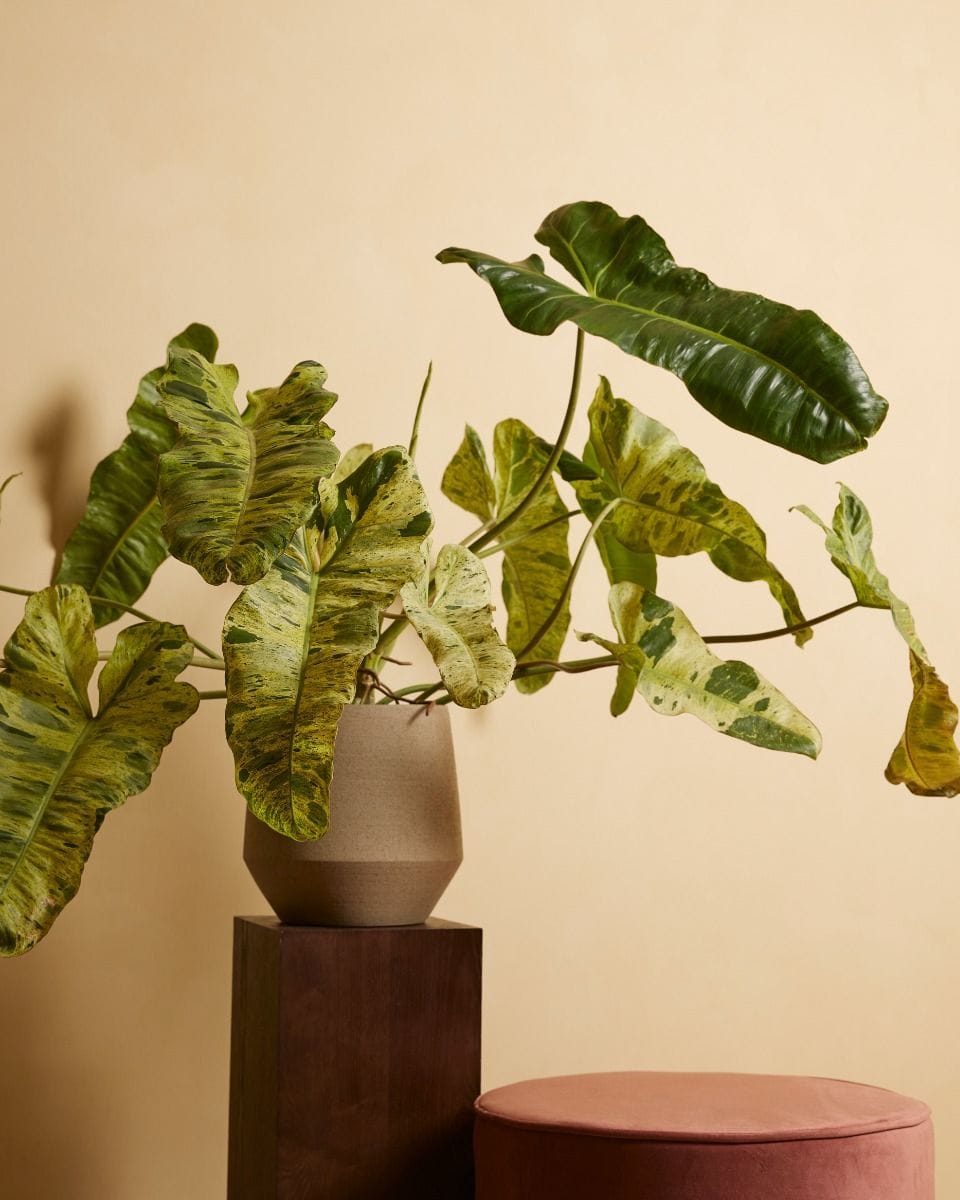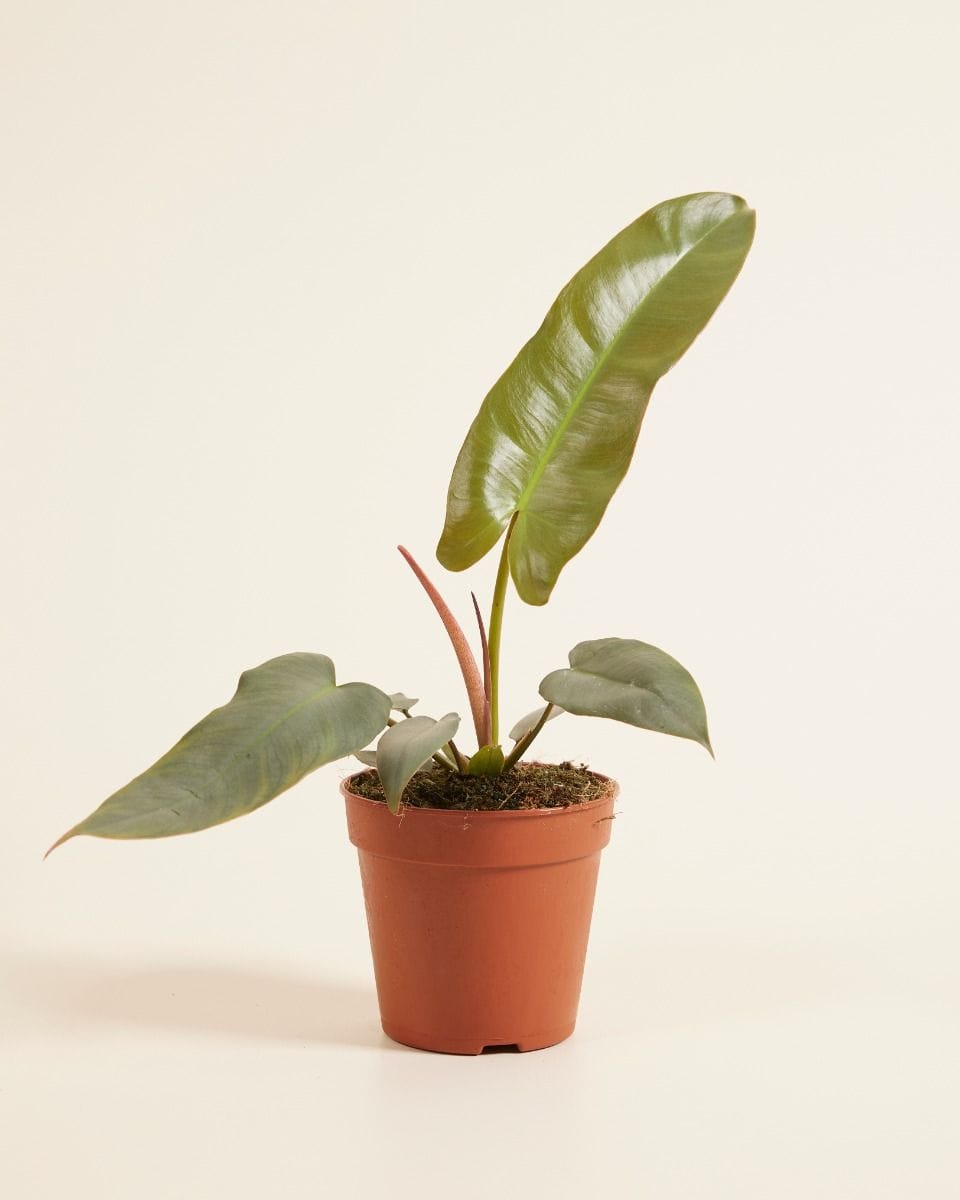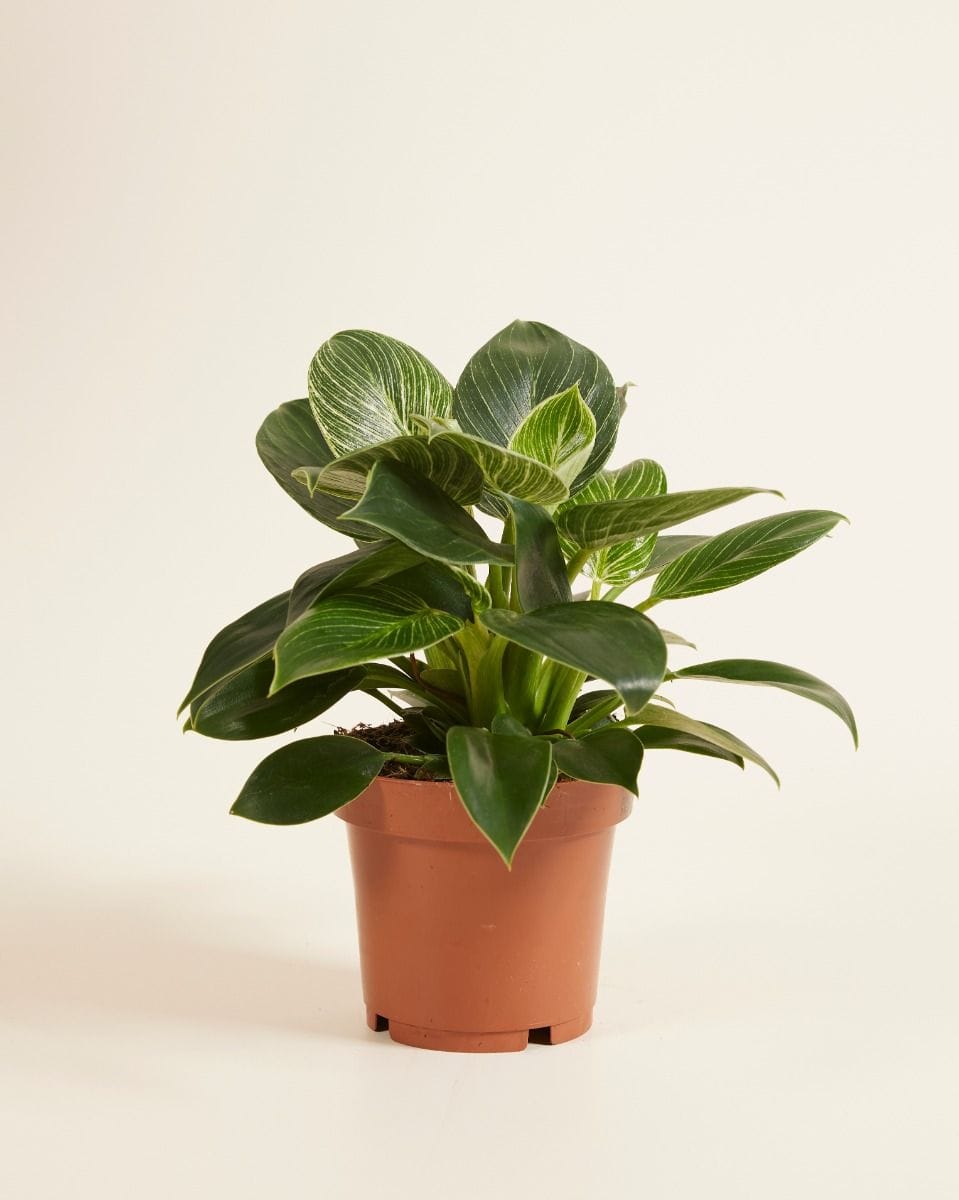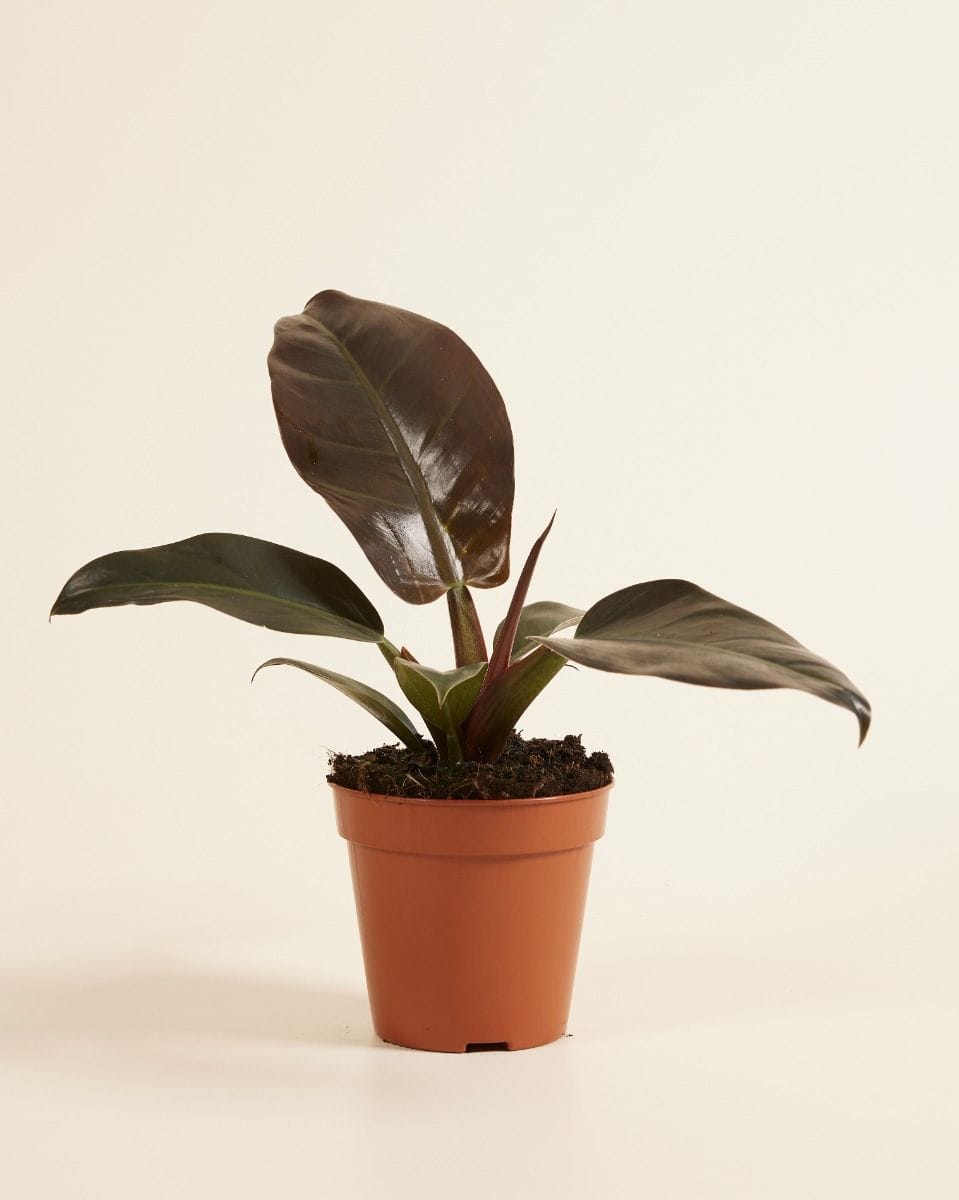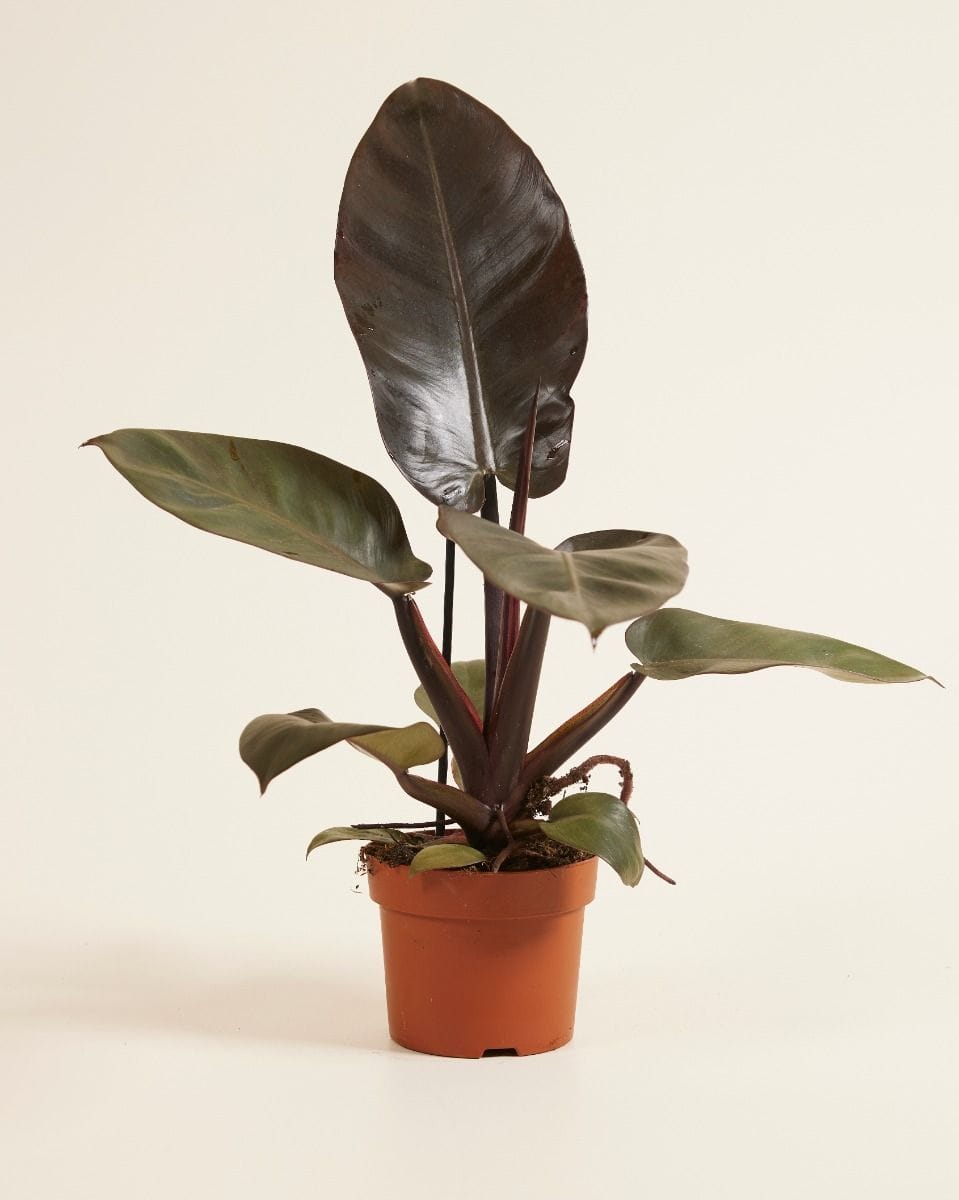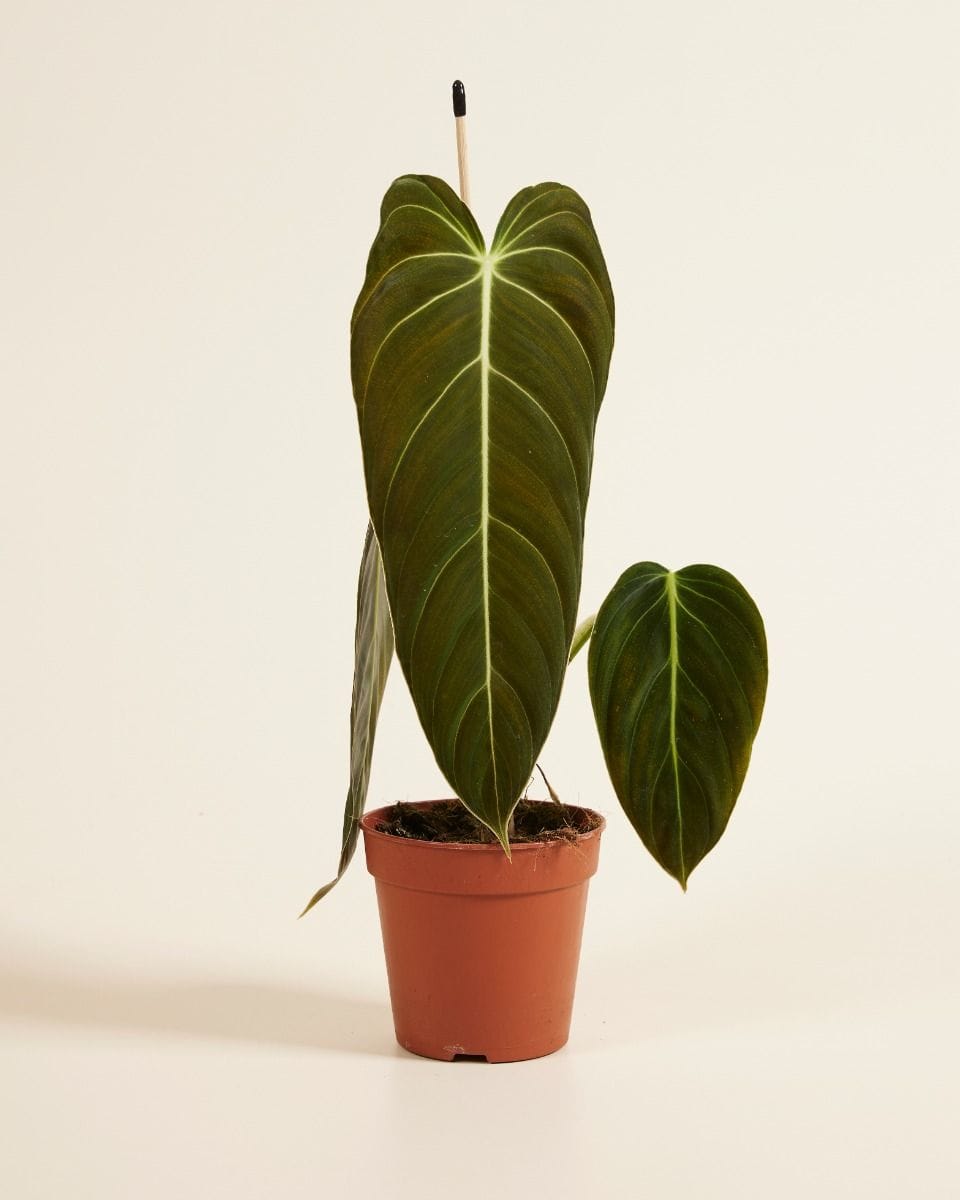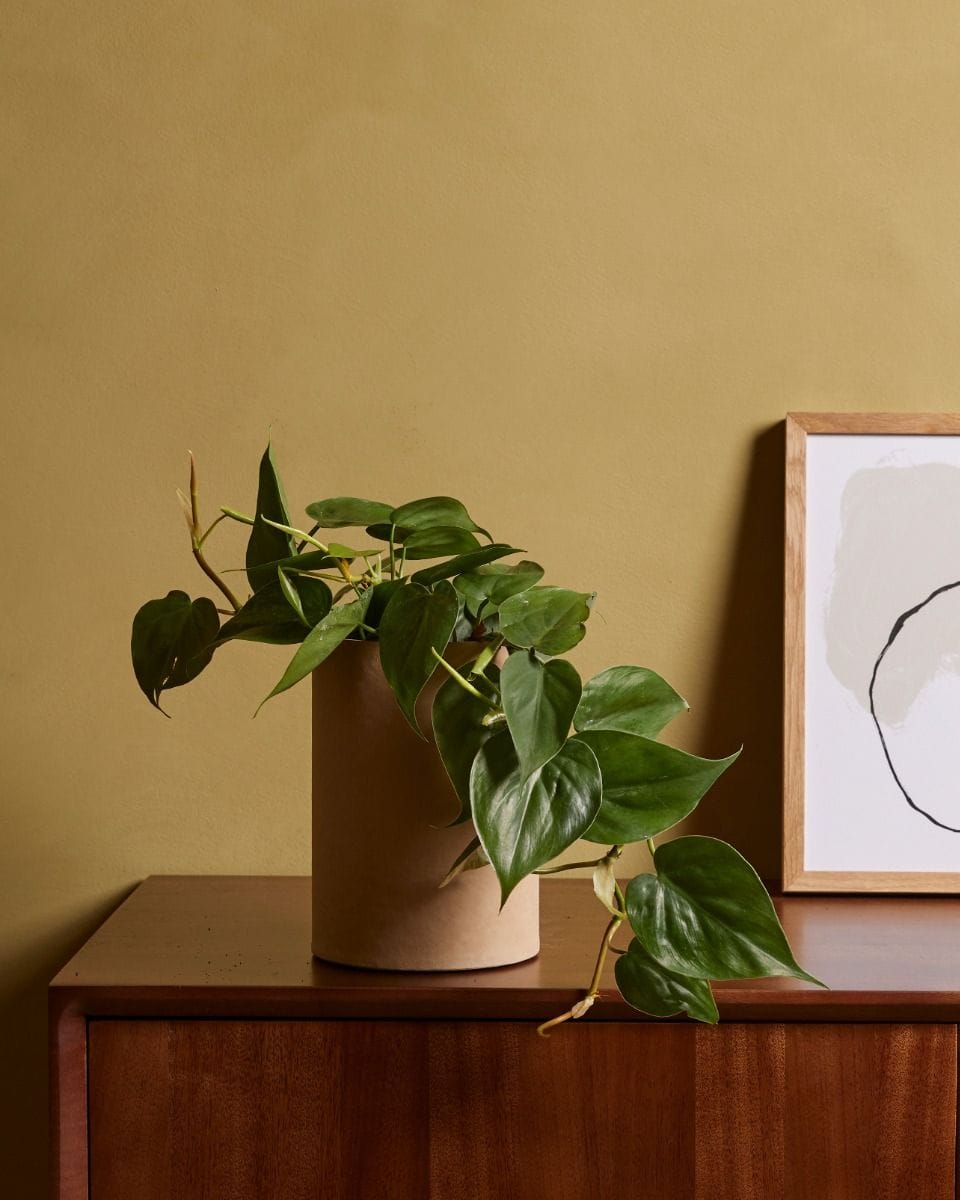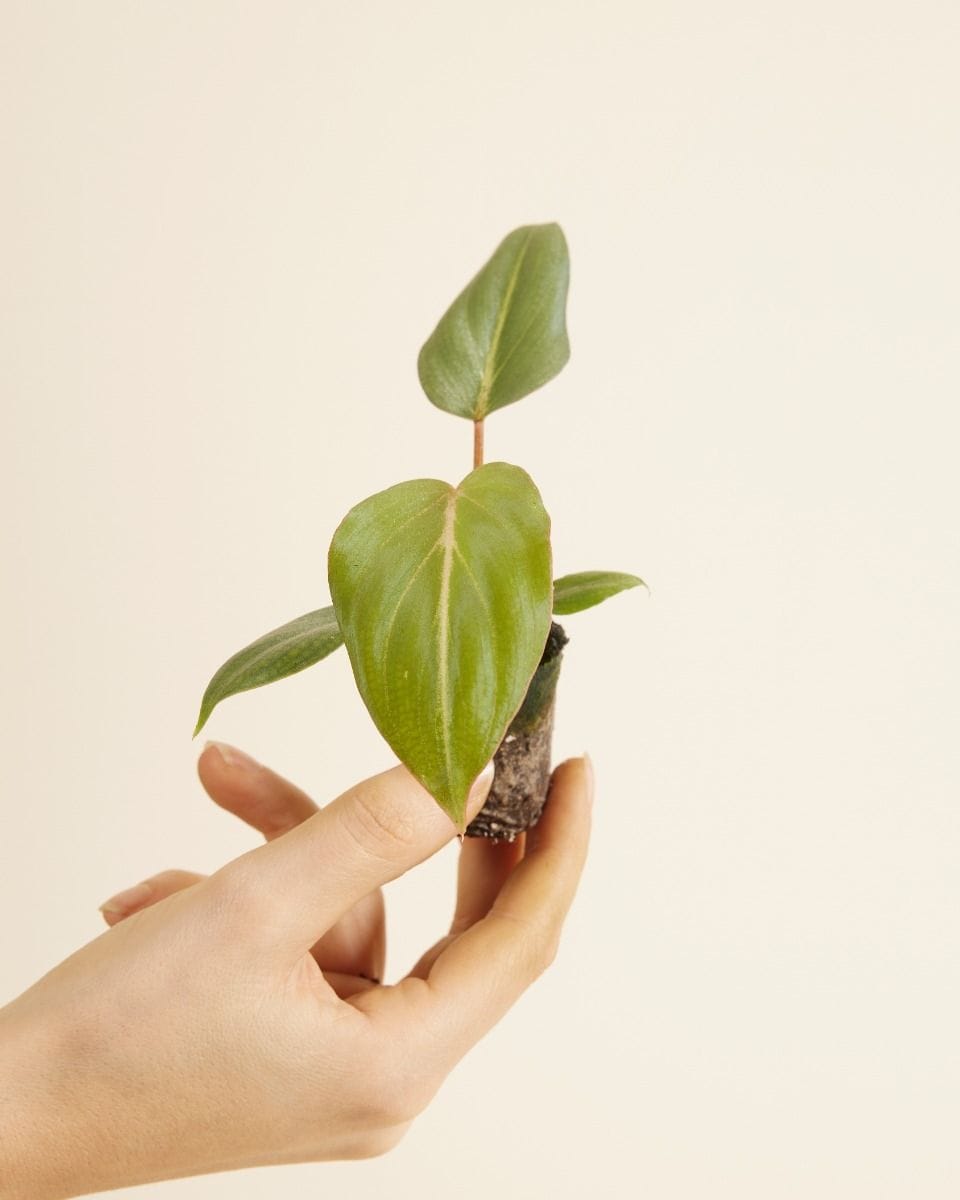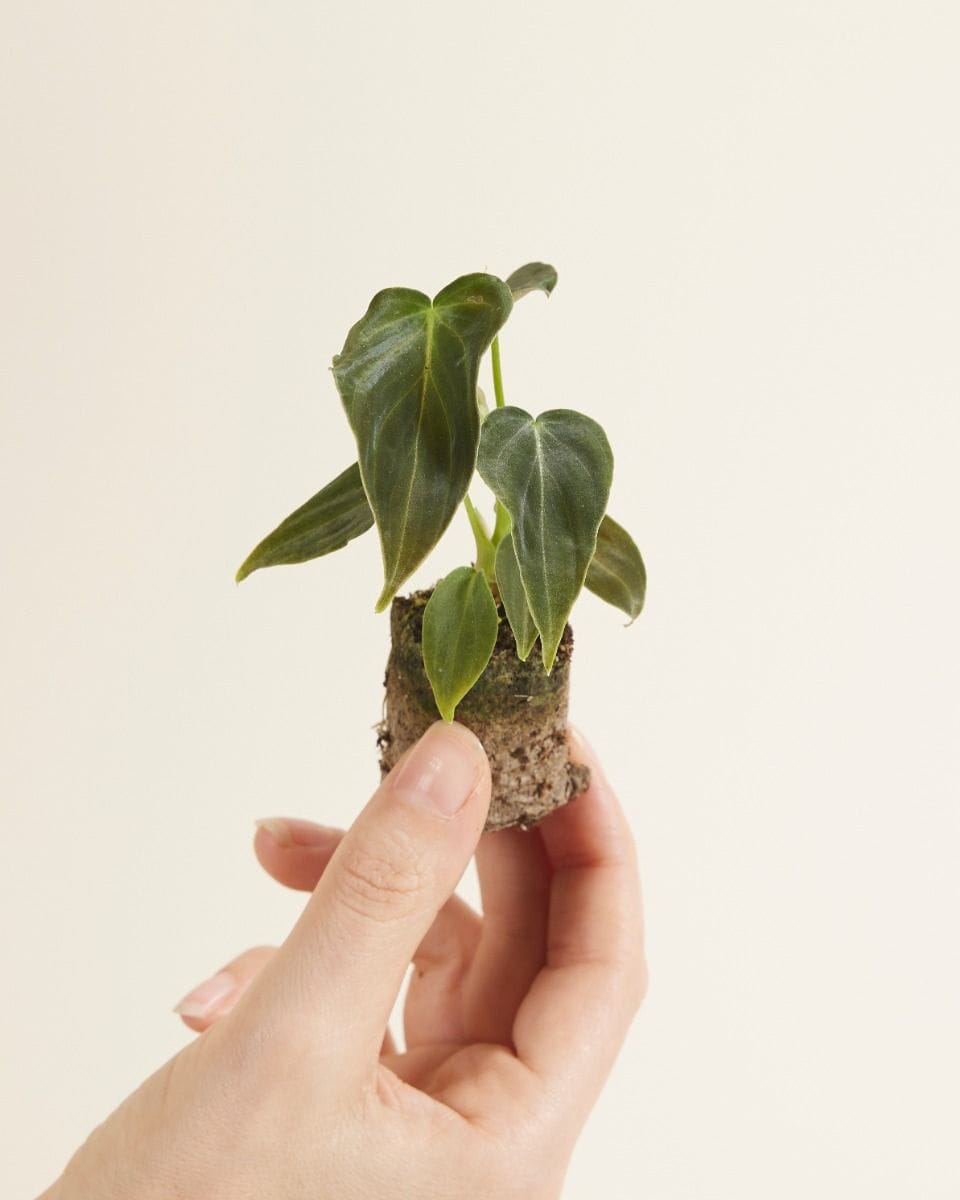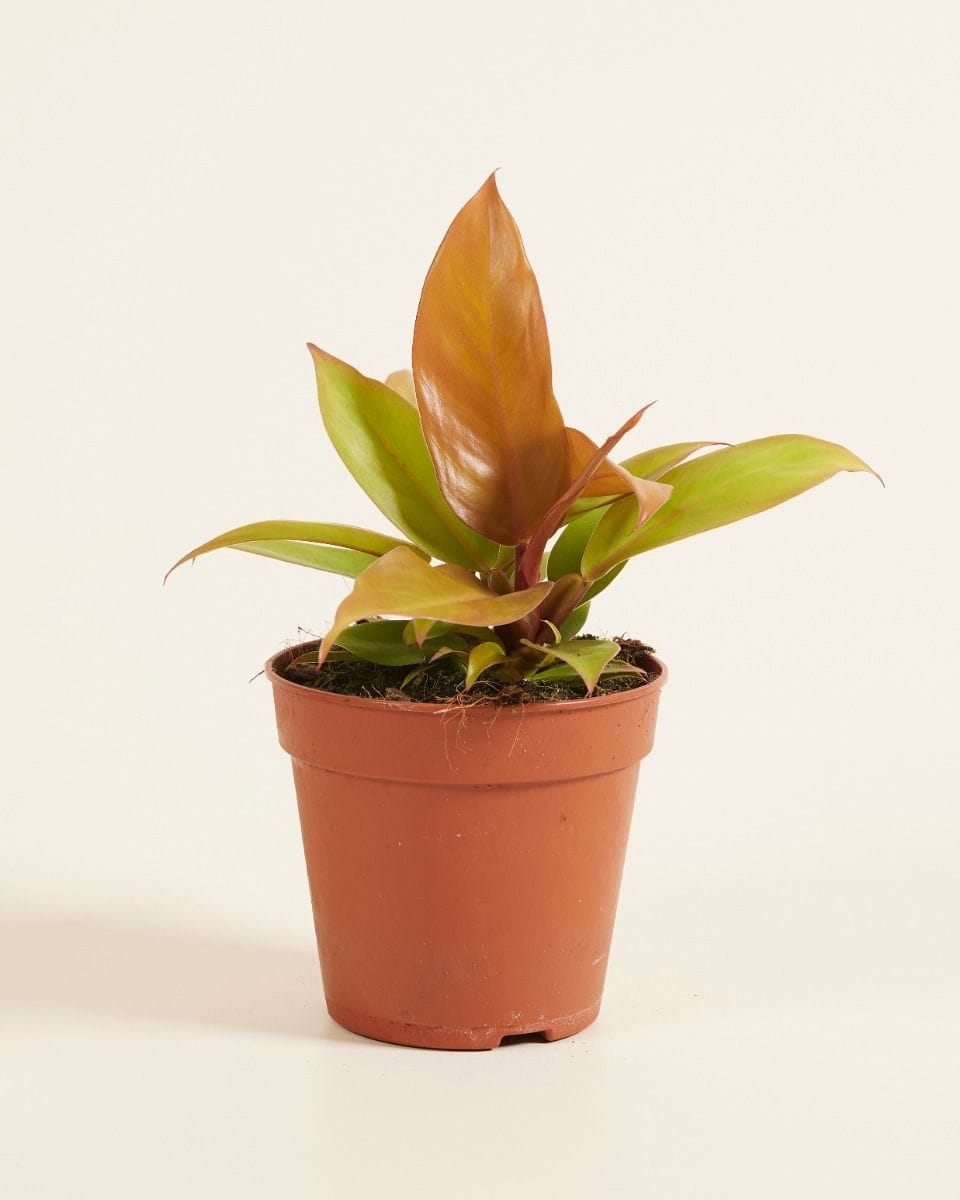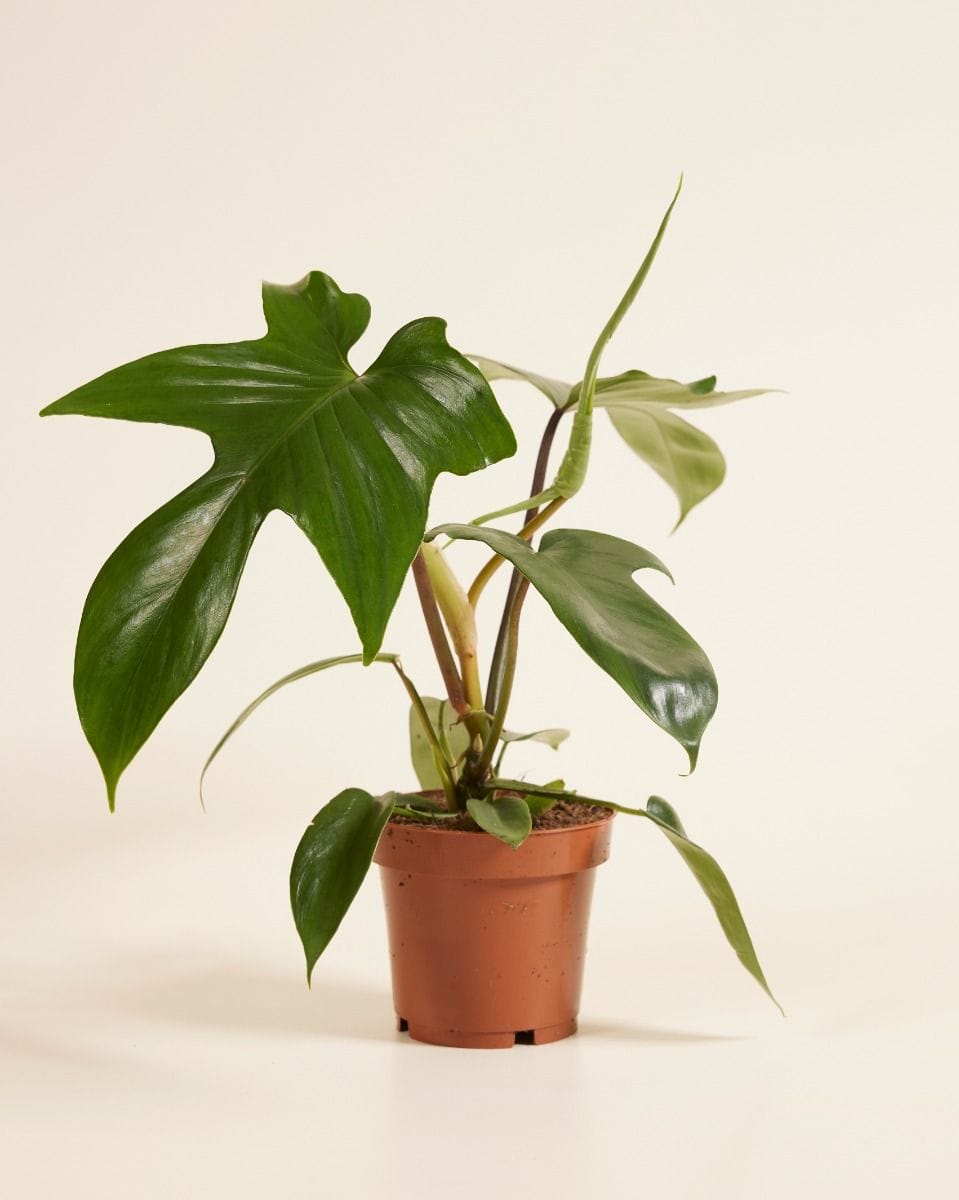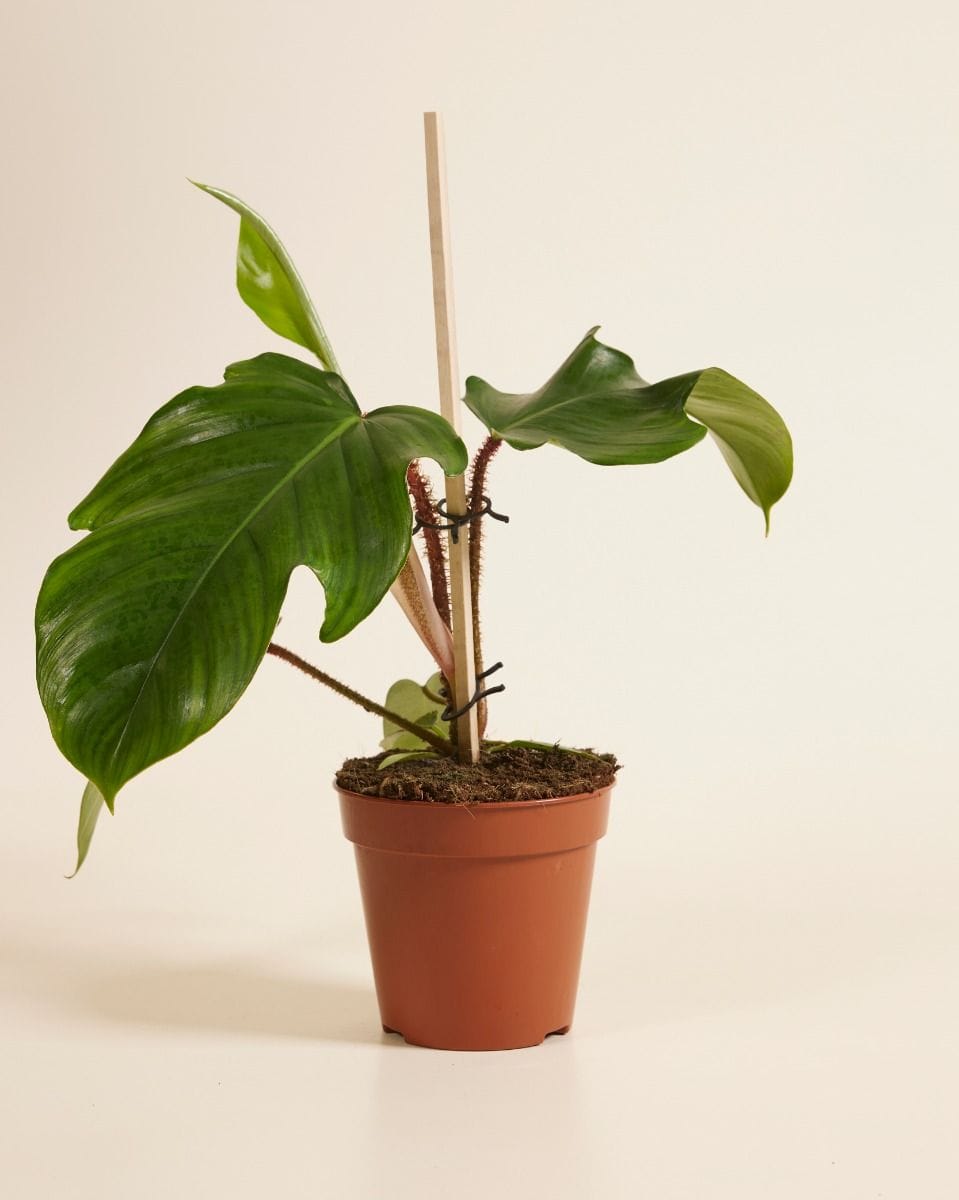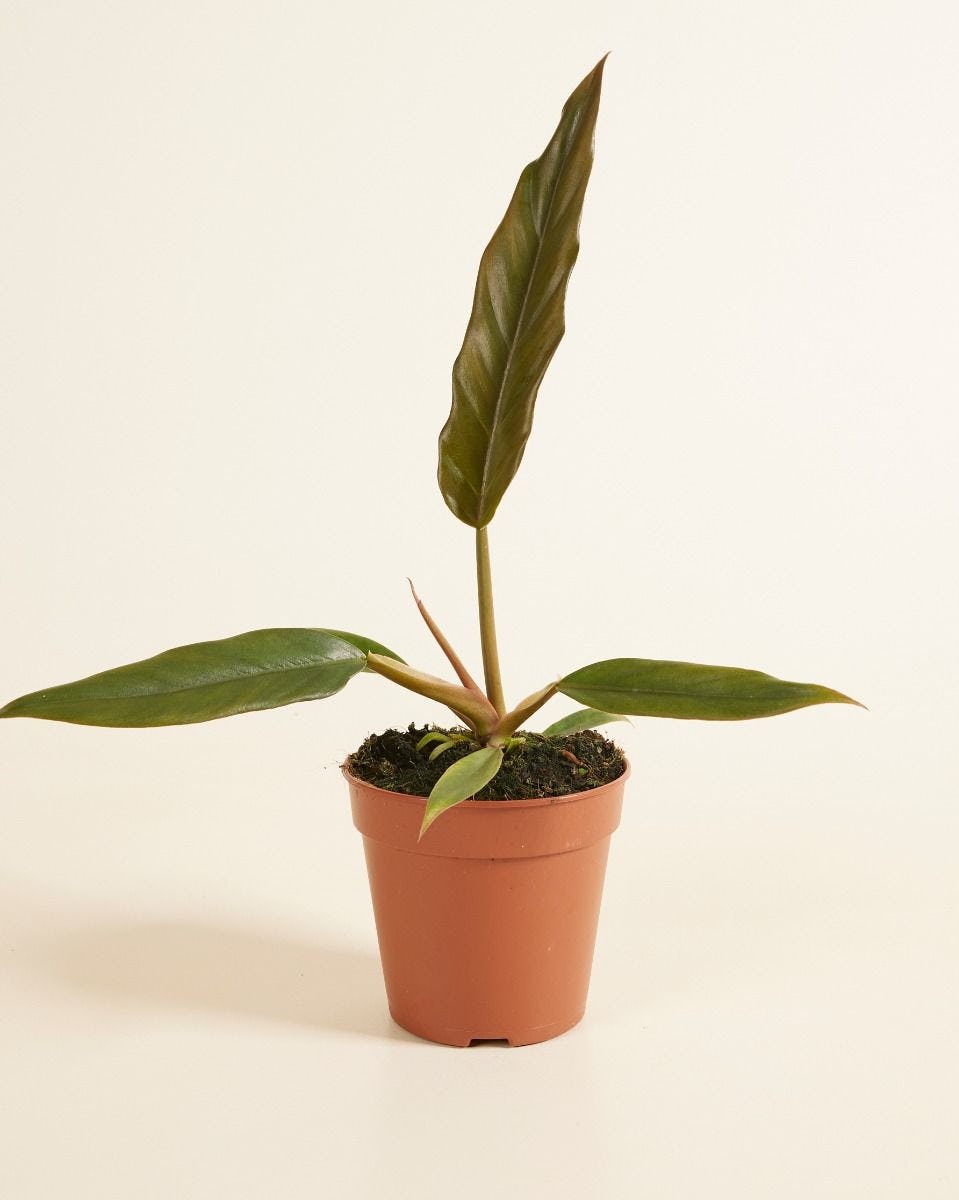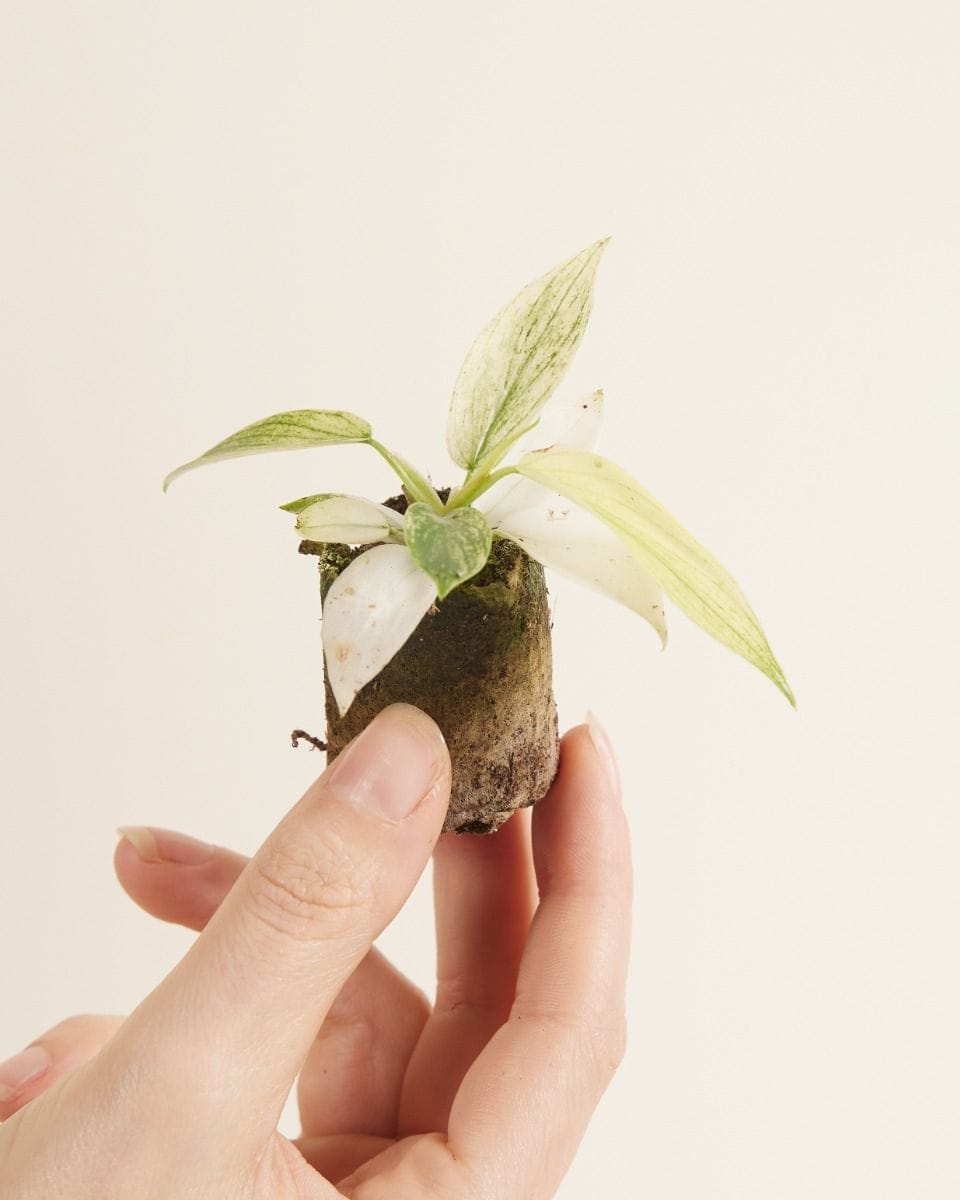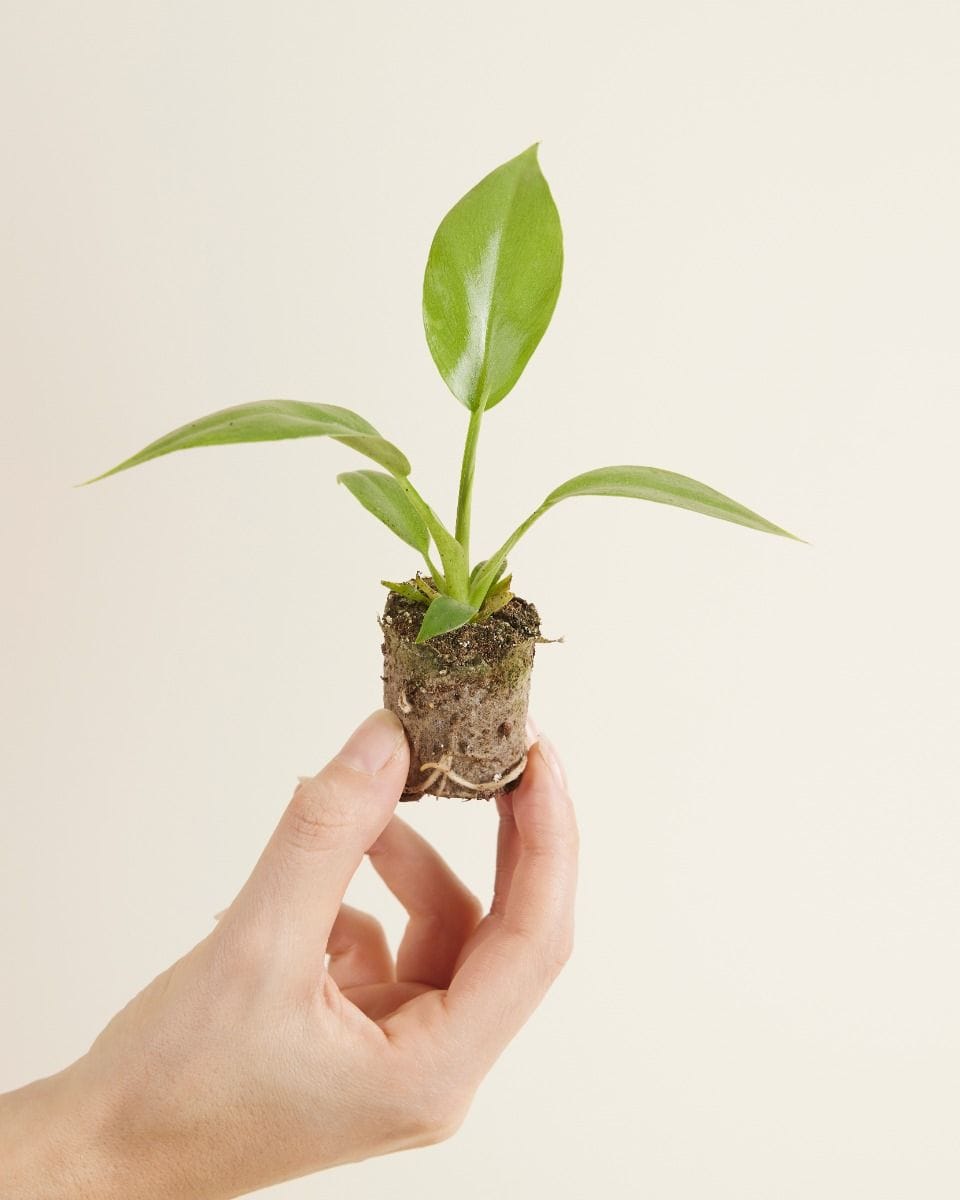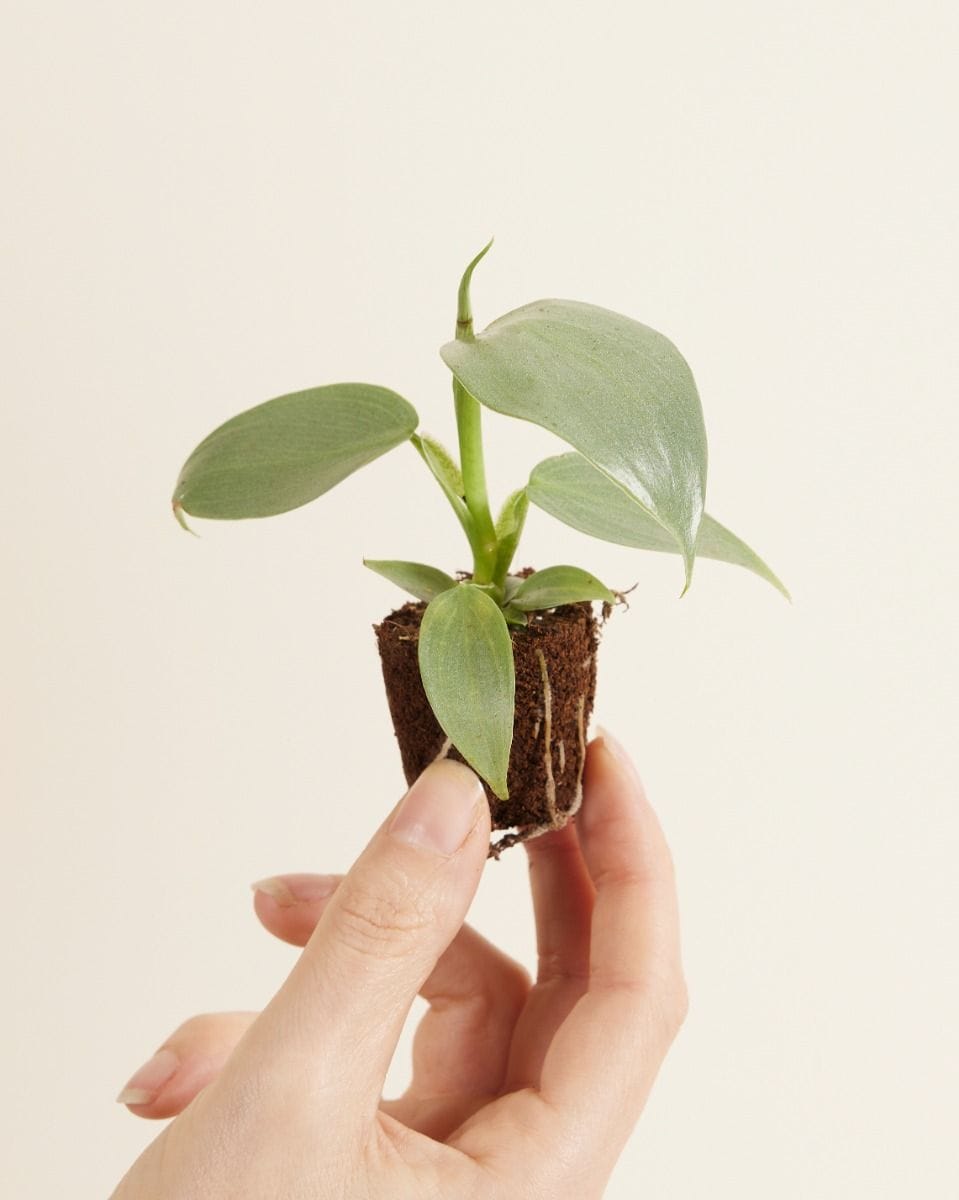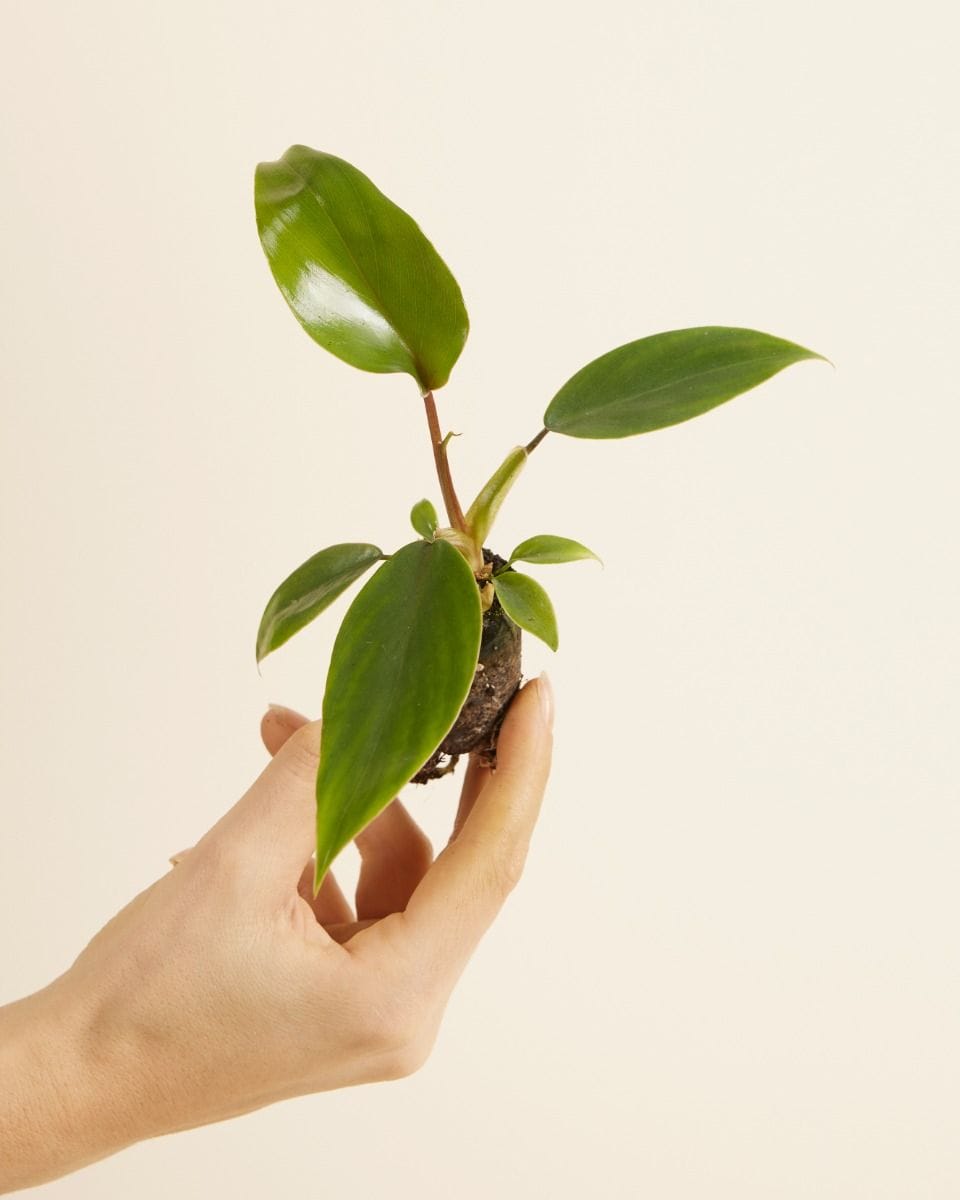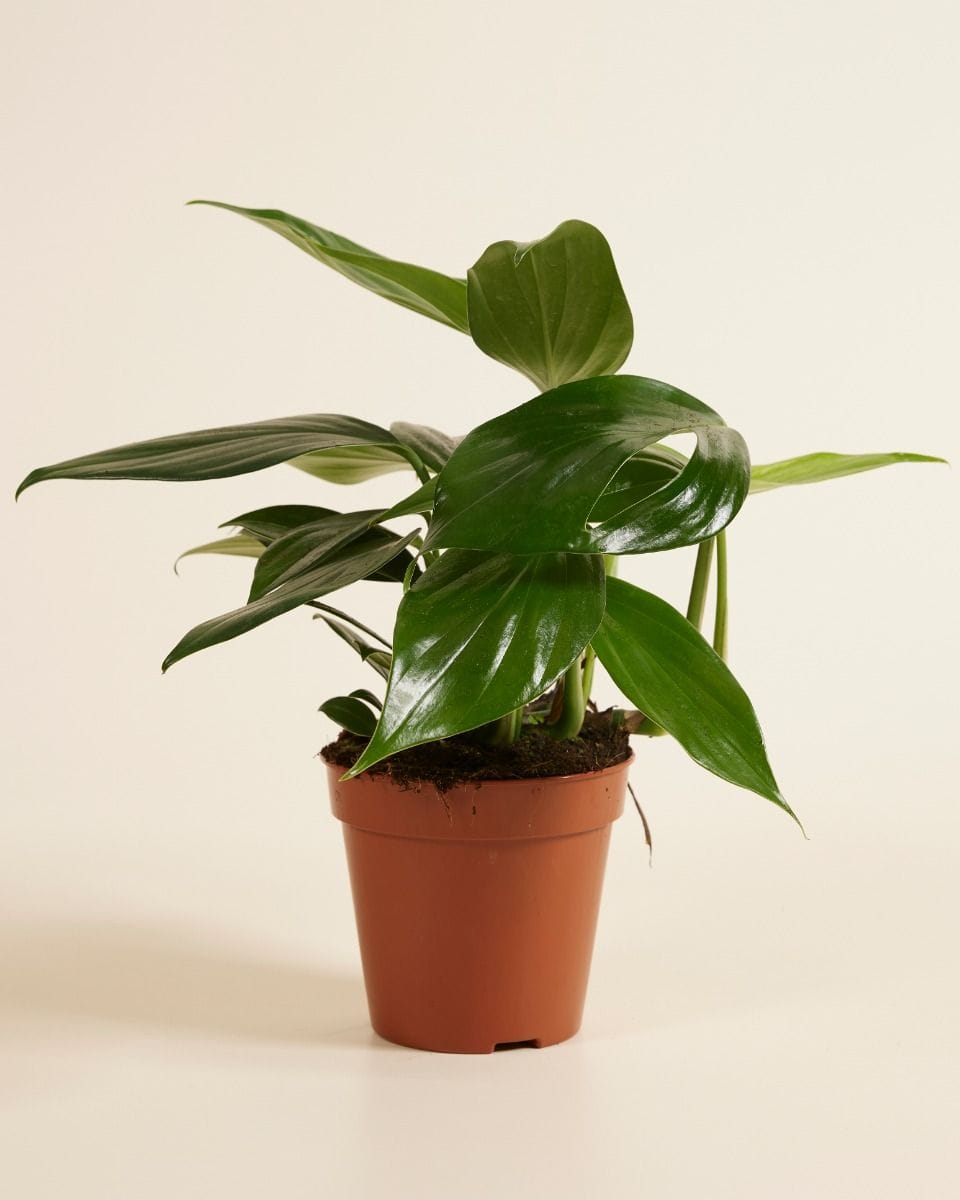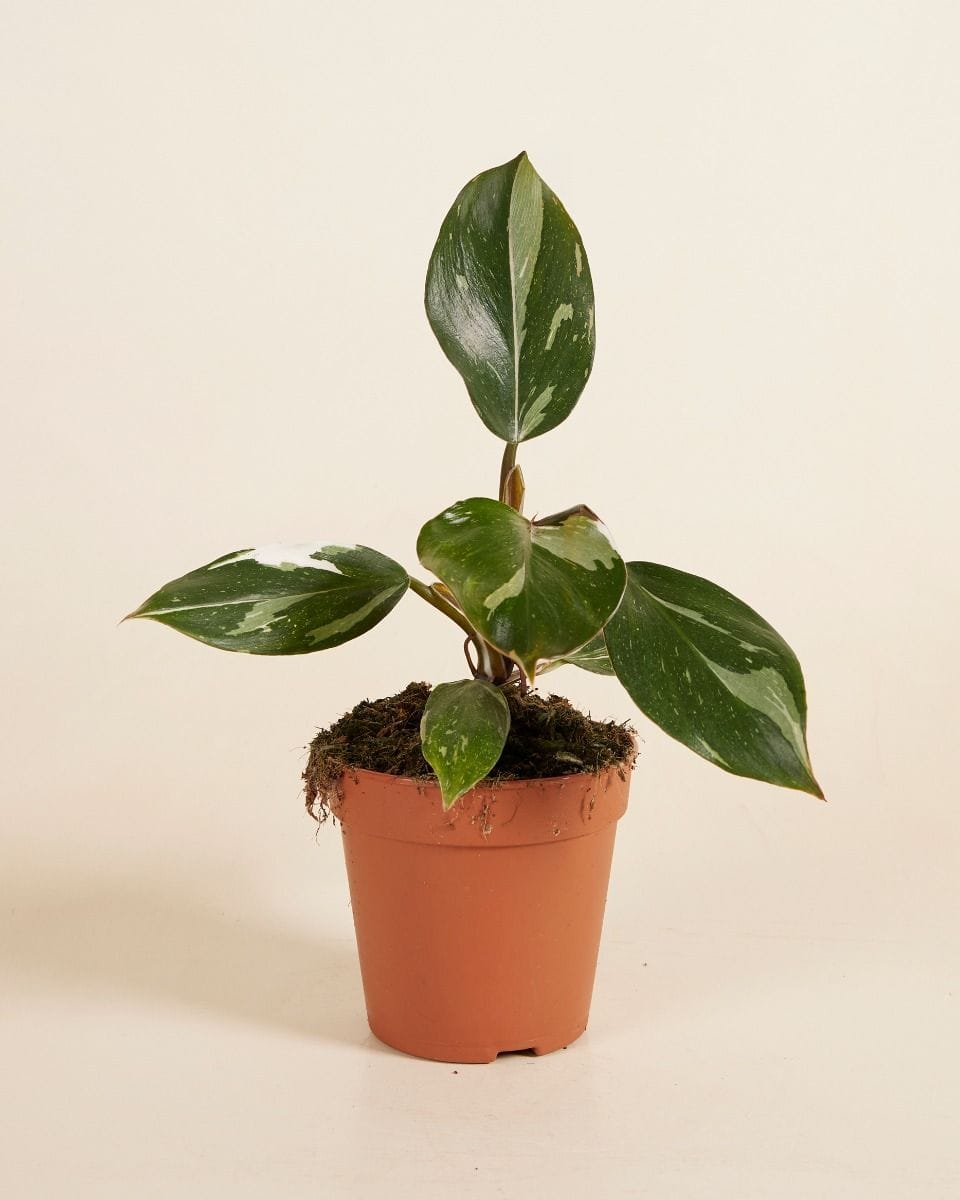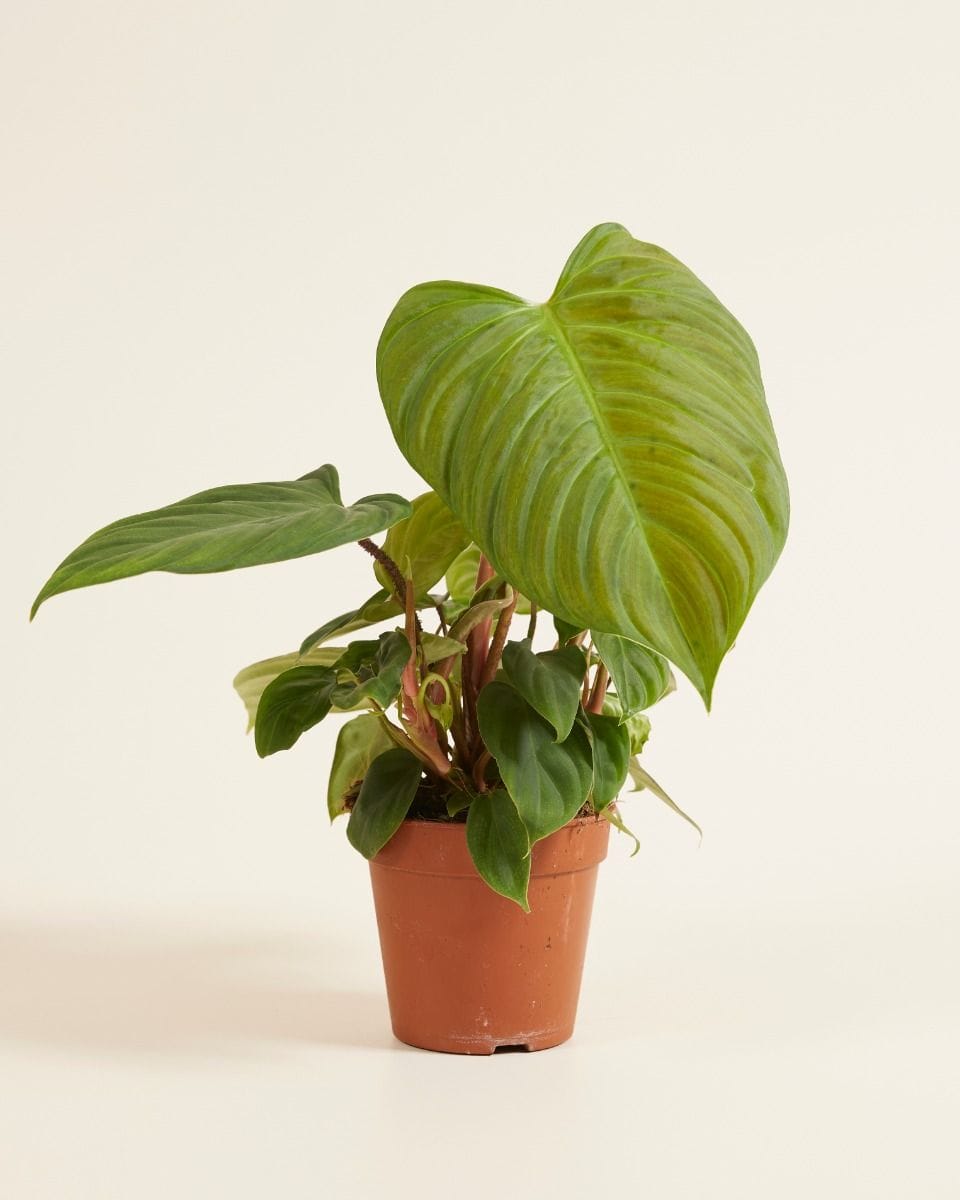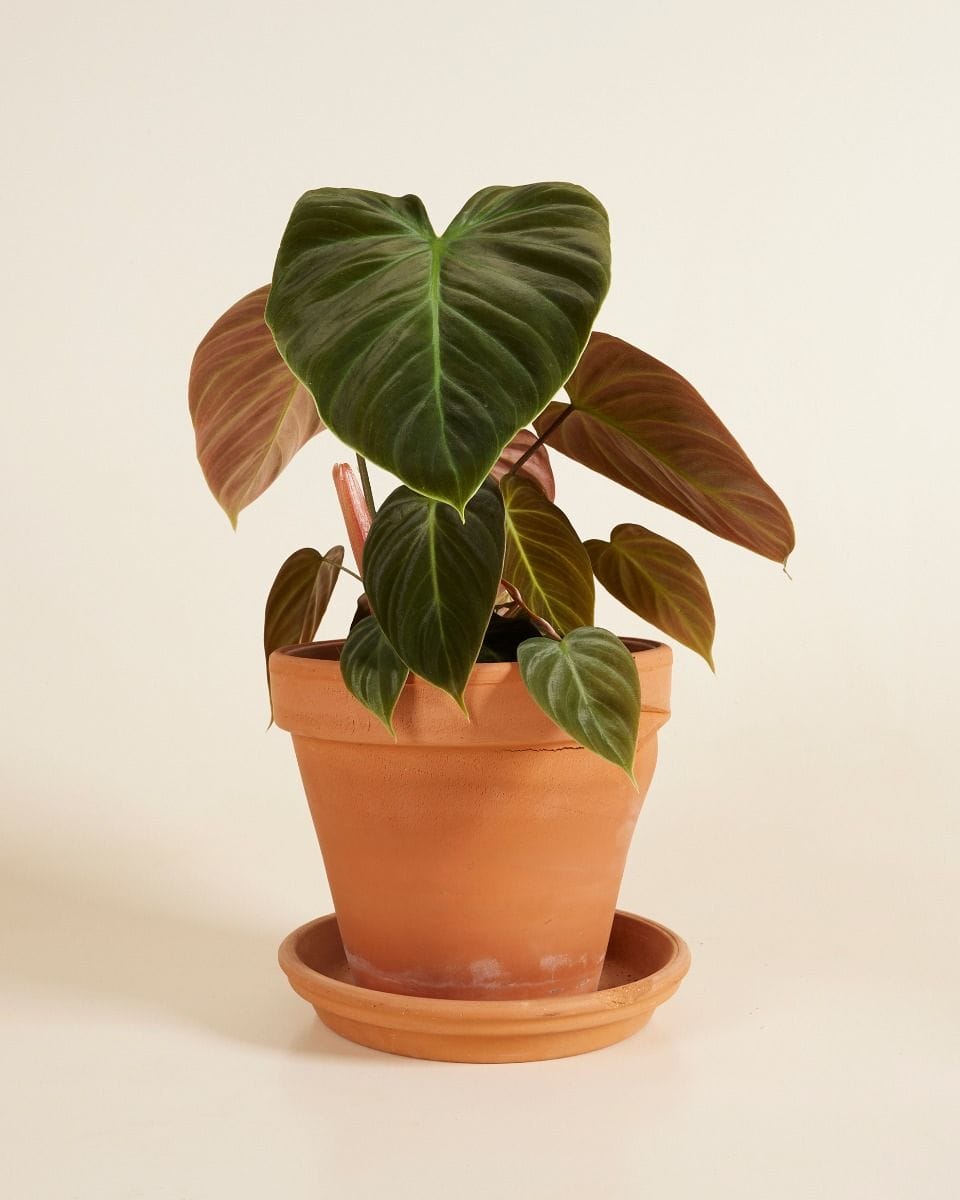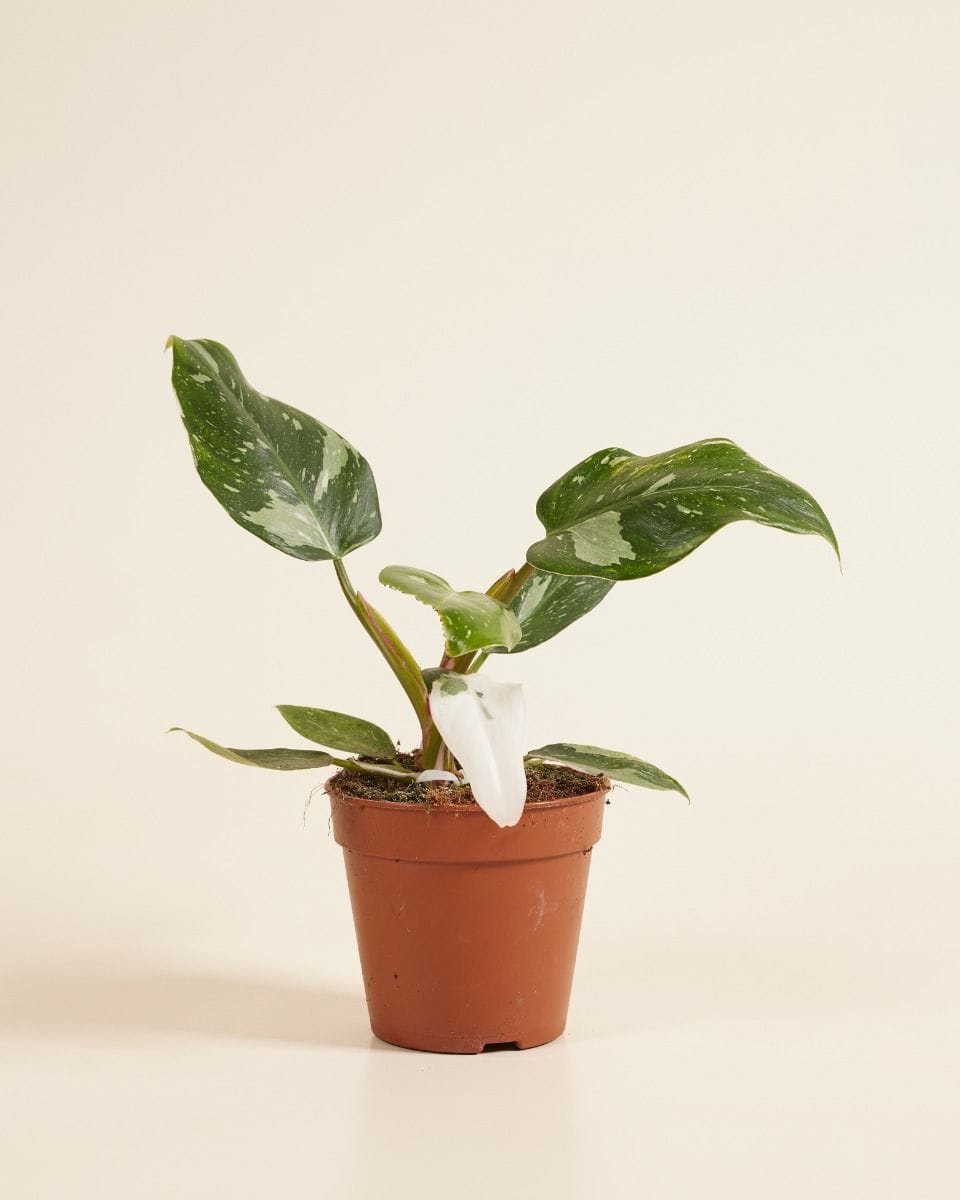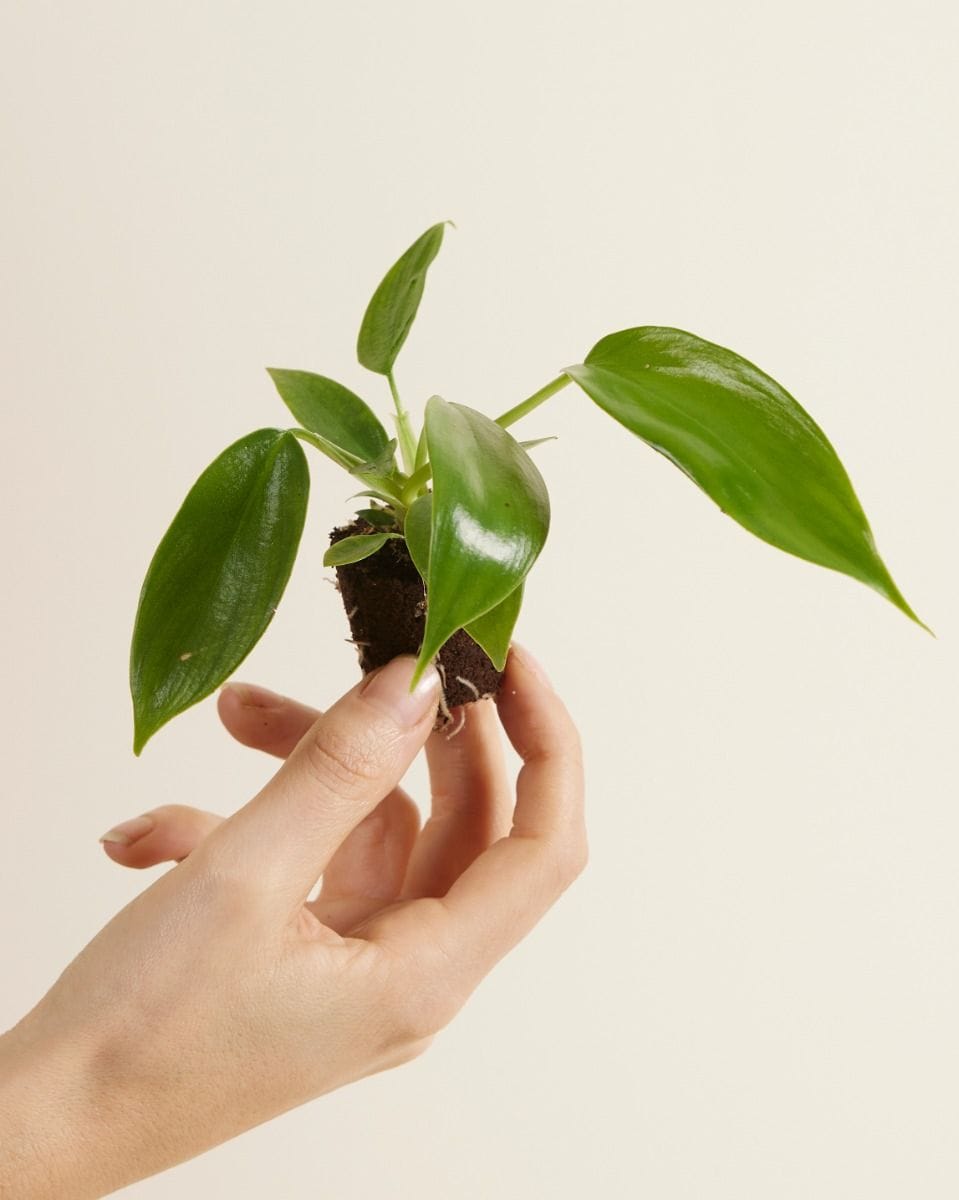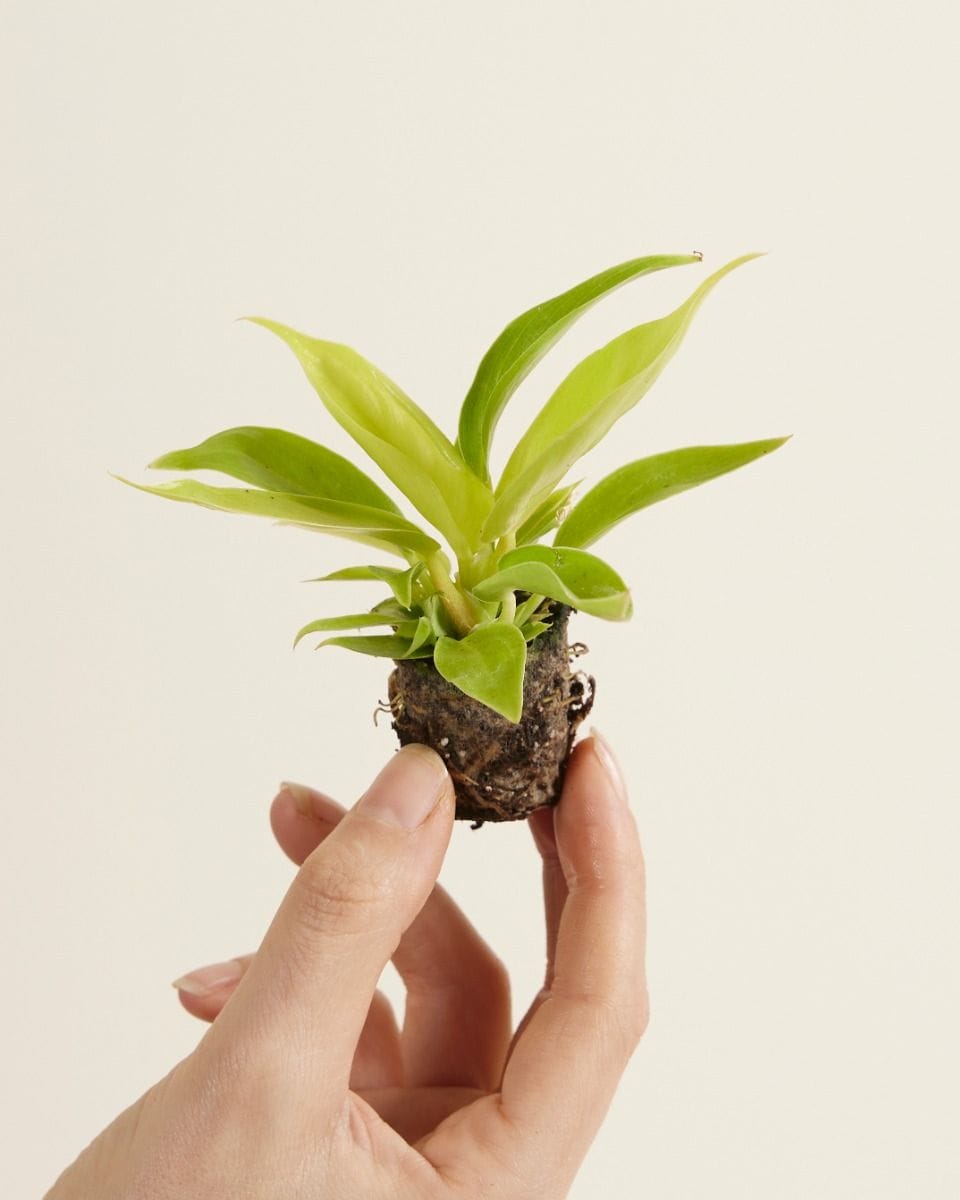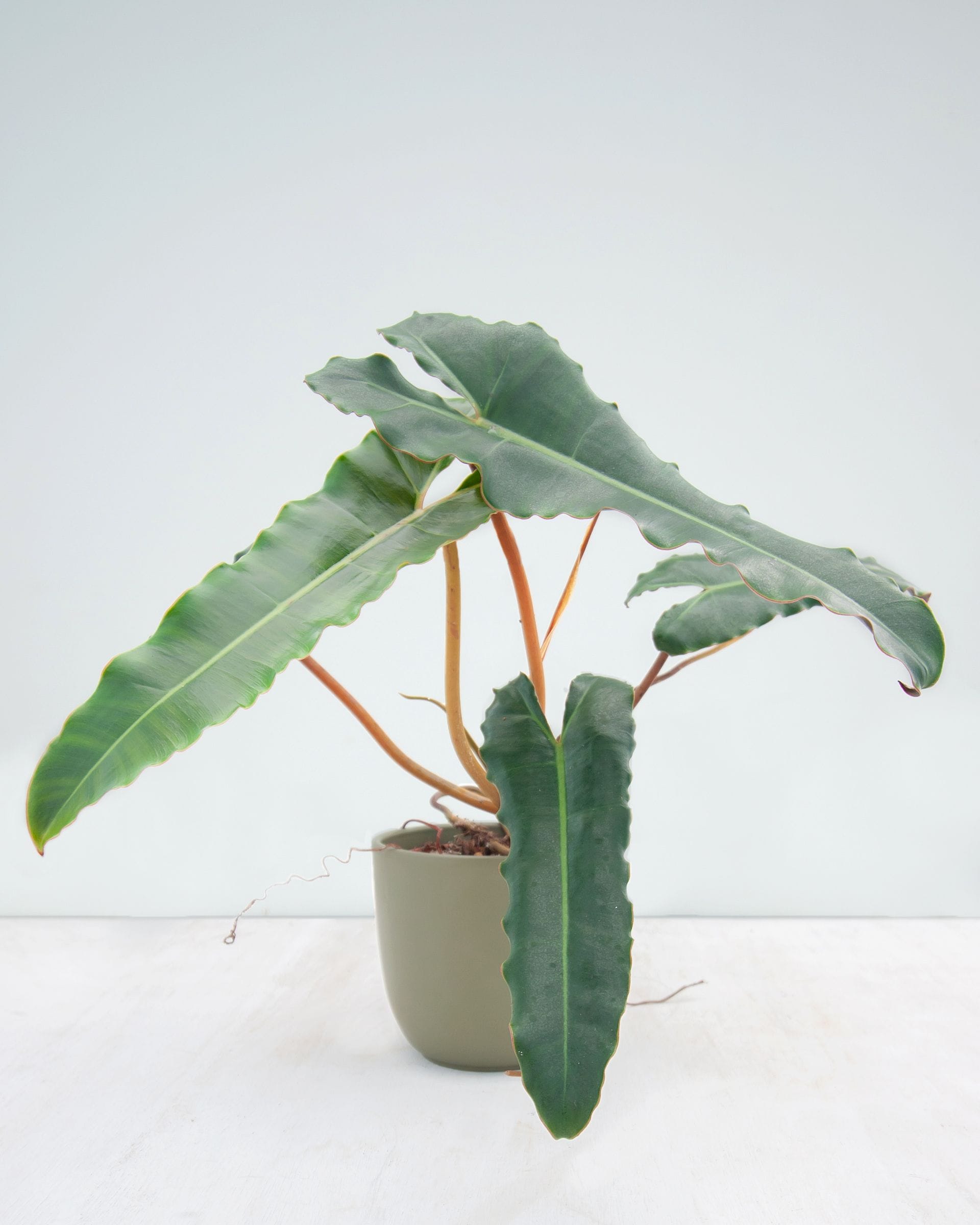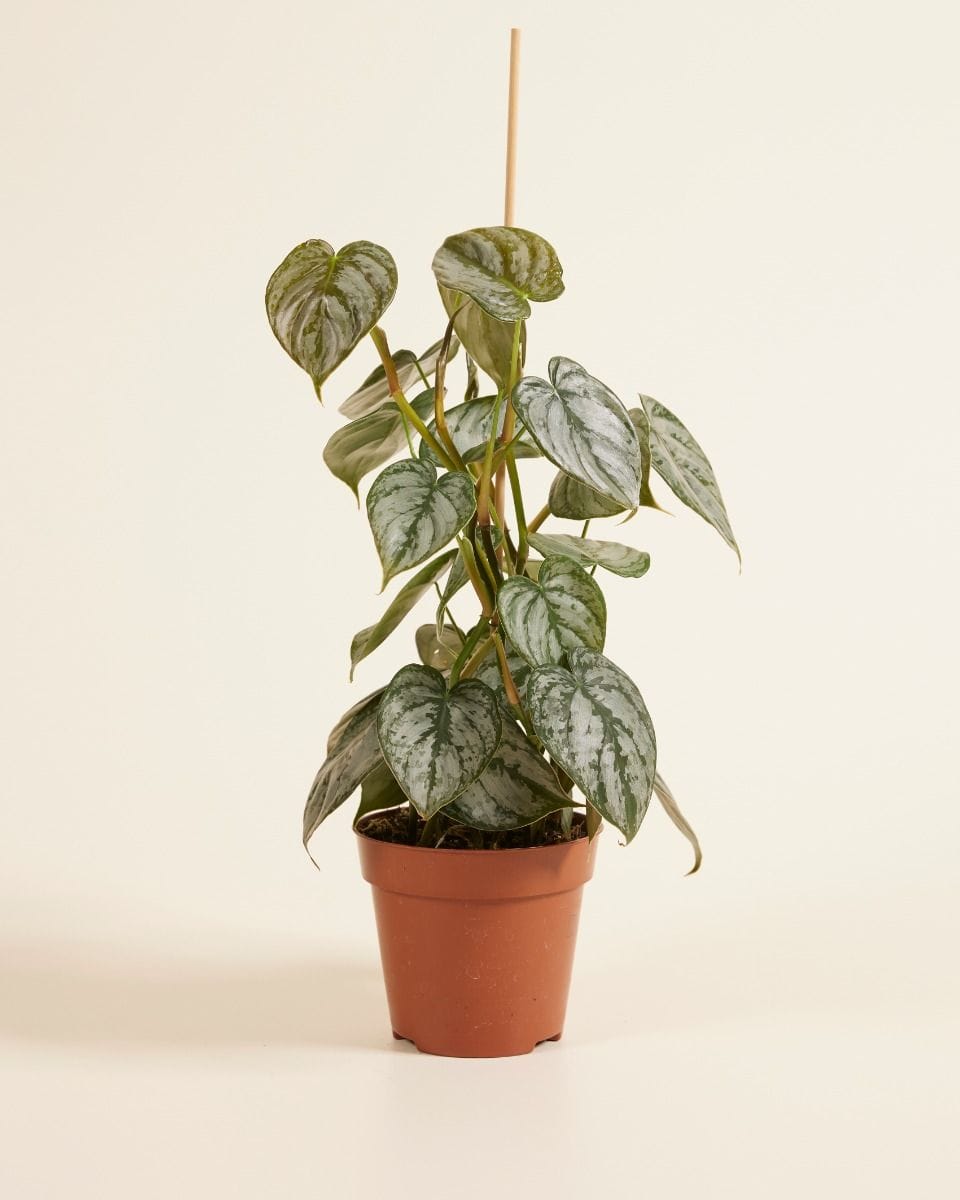En este artículo
- 1 Cómo cuidar el Filodendro (Árbol del amor): Consejos para el cuidado de las plantas de interior
- 1.1 Cuidados del filodendro: 10 consejos de expertos para cultivarlo con éxito
- 1.2 Cuidados del filodendro
- 1.2.1 Luz
- 1.2.2 Riega
- 1.2.3 Temperatura
- 1.2.4 Humedad
- 1.2.5 Trasplantar
- 1.2.6 Suelo
- 1.2.7 Abono
- 1.3 Propagación de los filodendros
- 1.4 Plagas y enfermedades más comunes en las plantas de Filodendro
- 1.5 Variedades de filodendro
- 1.6 Preguntas frecuentes sobre los filodendros (FAQ)
- 1.7 Comprar filodendro online en PLNTS.com
Cómo cuidar el Filodendro (Árbol del amor): Consejos para el cuidado de las plantas de interior
Los filodendros son una elección única y versátil para las plantas de interior, ya que están disponibles en varios tamaños, formas y colores. Desde el clásico Filodendro de hoja acorazonada, con sus delicadas hojas en forma de corazón, hasta el exótico Esmeralda rojo, con sus tallos de color rojo intenso y hojas verdes brillantes, hay un Filodendro que se adapta a cualquier estilo o espacio.
¡Dato curioso! ¿Sabías que a los filodendros se les conoce como árboles del amor? El filodendro recibe su nombre de las palabras griegas "Philo", que significa amor, y "Dendron", que significa árbol.
Como plantas tropicales fáciles de cuidar, los Filodendros son una elección excelente para principiantes y personas con un estilo de vida ajetreado. Además de ser increíblemente adaptables, las hojas del Filodendro son purificadoras del aire que recogen las partículas contaminantes y liberan oxígeno fresco y limpio.
En este artículo te daremos una guía detallada sobre cómo cuidar un Filodendro y mantenerlo sano y feliz.

Cuidados del filodendro: 10 consejos de expertos para cultivarlo con éxito
- Proporciona a tu filodendro mucha luz indirecta y brillante. Si se cultiva en condiciones demasiado tenues, puede volverse patilargo y tener hojas más pequeñas y amarillas.
- Evita colocarlo bajo la luz solar directa. La luz solar excesiva puede hacer que las hojas se quemen, lo que puede provocar estrés a la planta.
- Riega la planta con regularidad, dejando que la tierra se seque ligeramente entre riegos. Comprueba los niveles de humedad del suelo antes de regar para evitar que se pudran las raíces.
- Abona el filodendro cada dos meses durante el período vegetativo con un abono líquido equilibrado que aporte los nutrientes necesarios para su crecimiento.
- Asegúrate de que tu filodendro tenga agujeros de drenaje y un suelo que drene bien. Así evitarás que se pudran las raíces.
- Evita colocar tu Filodendro cerca de ventanas o puertas con corrientes de aire, ya que los cambios bruscos de temperatura pueden dañar las hojas y hacer que la planta se marchite.
- Comprueba regularmente si tu planta tiene plagas como pulgones, cochinillas y arañas rojas. Si observas alguna infestación, trátala inmediatamente con un producto adecuado para el control de plagas.
- Si tu planta de filodendro empieza a amarillear o a caerse, puede ser un signo de riego excesivo o insuficiente. Ajusta el programa de riego y vigila de cerca la planta para asegurarte de que se recupera.
- Trasplanta tu filodendro cada uno o dos años. Elige una maceta ligeramente más grande que la anterior. Asegúrate de que la tierra esté fresca y la planta tenga espacio suficiente para crecer.
- Limpia regularmente las hojas de la planta con un paño húmedo para eliminar el polvo y los restos. Los filodendros tendrán mejor aspecto, ¡y mejorará la fotosíntesis!
Tipos de filodendro
Hay varios tipos de plantas de interior filodendro, cada uno con sus propios requisitos de cuidado. A algunos Filodendros les gusta trepar y pueden incluso cubrir paredes; otros pueden verse como árboles en miniatura (de interior).
Algunos tipos populares de Filodendros son:
-
Filodendro de hoja de corazón: Este tipo de Filodendro enredadera tiene hojas largas en forma de corazón y es conocido por su capacidad para crecer en condiciones de poca luz. Requiere un riego regular, pero puede ser sensible al riego excesivo.
-
Filodendro de hoja partida: También conocido como Filodendro arbóreo. Este tipo de filodendro tiene hojas grandes y partidas, y puede crecer bastante. Prefiere la luz solar brillante e indirecta y el riego regular, pero puede ser sensible a las temperaturas frías.

-
Filodendro oreja de elefante: Este tipo de Filodendro tiene hojas grandes, onduladas y de color verde intenso que parecen orejas de elefante. Prefiere la luz brillante e indirecta y el riego regular, pero puede ser sensible al riego excesivo.
-
Filodendro de hoja roja: Este tipo de Filodendro tiene hojas de color rojo oscuro y es conocido por su capacidad para crecer en condiciones de poca luz. Requiere un riego regular, pero puede ser sensible al riego excesivo y a las bajas temperaturas.

En general, es importante comprobar los requisitos específicos de cada variedad de Filodendro que estés cuidando. A pesar de ser de la misma familia, pueden presentar algunas diferencias. Con los cuidados adecuados, los Filodendros pueden florecer durante años, aportando belleza y oxígeno a tu hogar.
Cuidados del filodendro
Luz
Aunque los filodendros suelen considerarse plantas de poca luz, prosperan con luz indirecta de media a intensa. La luz indirecta brillante es un tipo de luz solar suave y difusa. Evita ponerlos directamente al sol, ya que demasiada luz solar puede chamuscar sus hojas. En la naturaleza, crecen bajo las copas de árboles altos, donde sólo reciben luz solar difusa.
Si tu filodendro tiene hojas más pequeñas, las patas largas y un gran espacio entre las hojas, es posible que necesite más luz. Considera la posibilidad de elegir un lugar más luminoso o de utilizar luces de cultivo.
Riega
Deja que la tierra se seque ligeramente entre riegos. Así evitarás que las raíces se estanquen en el agua, lo que puede provocar la pudrición de las raíces. Los filodendros son muy sensibles al riego excesivo.
Consejo para el riego El mejor momento para regar es cuando la media capa superior de la tierra esté ligeramente seca. Cuando dudes de la necesidad de regar tus filodendros, recuerda que la tierra seca es mejor que la húmeda. Si quieres asegurarte de que la tierra no está húmeda, utiliza un medidor de agua para medirla.
Las hojas caídas pueden significar que la planta está recibiendo demasiada o poca agua. Las hojas se recuperarán rápidamente cuando corrijas el programa de riego. Las hojas amarillas pueden indicar que la rutina de riego actual no es adecuada para tu planta de interior. Encontrar la rutina de riego adecuada puede llevar algún tiempo y experimentación.
Temperatura
Los filodendros crecen mejor entre 19 y 29°C, lo que los convierte en la planta de interior perfecta para la mayoría de los hogares. Temperaturas tan bajas como 10°C pueden tolerarse durante un breve periodo, pero el crecimiento puede ralentizarse o atrofiarse.
¿Es seguro sacarla al exterior en verano (Europa)?
Puedes sacar tu filodendro al exterior en verano, cuando las temperaturas sean cálidas. Asegúrate de meterlo antes de las noches frías. Debes mantenerlo alejado de la luz solar directa y de los vientos fuertes.
Humedad
Como plantas de la selva tropical, también prefieren condiciones húmedas. Lo mejor es un nivel de humedad del 50-60%, pero también pueden sobrevivir a un nivel inferior. Puedes medir la humedad del aire con un higrómetro o sensor de humedad.

Cuando la humedad desciende por debajo del 40%, se recomienda aumentarla para mantener las plantas sanas. Puedes rociar con agua las hojas de tu planta, colocarla en una bandeja de guijarros llena de agua o utilizar un humidificador ambiental para aumentar la humedad.
Trasplantar
Trasplantar regularmente el filodendro a tierra fresca es esencial para su cuidado. Ayuda a mantener su salud y crecimiento. Cuando lo trasplantes, elige una maceta un tamaño mayor que la actual para que las raíces tengan espacio suficiente para crecer. Asegúrate de incluir orificios de drenaje para evitar que se encharque.
El mejor momento para trasplantar un Filodendro es durante la primavera, cuando la planta está creciendo activamente. Evita trasplantarlo en otoño o invierno, ya que la planta es más vulnerable al estrés durante estos periodos de letargo. Si las raíces de tu filodendro se salen de la maceta o si tiene algún problema de salud, puede ser seguro trasplantarlo también durante el invierno.
Suelo
Al elegir la tierra adecuada para tu planta de filodendro, es esencial buscar una mezcla que drene bien y sea rica en materia orgánica. A los filodendros no les gusta estar en tierra empapada, que puede provocarles varios problemas de salud. Una tierra para macetas de buena calidad mezclada con perlita o vermiculita proporcionará el drenaje y la aireación que tu filodendro necesita para prosperar.
Latierra orgánica para macetas PLNTS es ideal para todo tipo de filodendros. Con la tierra adecuada, tu filodendro puede absorber fácilmente la humedad y los nutrientes, lo que se traduce en un crecimiento sano y un hermoso follaje.
Abono
Tu filodendro utiliza todos los nutrientes de la tierra, por lo que debes volver a enriquecerla con nuevos nutrientes de vez en cuando. Riega la planta con abono líquido mensualmente en primavera y verano, y cada seis u ocho semanas en otoño e invierno. El alimento para plantas PLNTS Nutrition contiene todo lo necesario para el crecimiento sano de los filodendros.
El tamaño pequeño de las hojas y el crecimiento lento es su forma de decirte que no está recibiendo suficiente abono. Las hojas nuevas pálidas suelen indicar que la planta no está recibiendo suficiente calcio y magnesio, que son micronutrientes esenciales para los filodendros.
Propagación de los filodendros
La forma más habitual de propagar las plantas de filodendro es por división y esquejes de tallo. La propagación por división es mejor para plantas maduras con un sistema radicular denso, mientras que la propagación por esquejes de tallo es mejor para plantas más jóvenes y en crecimiento activo. Te recomendamos que compruebes siempre cuál es la mejor forma de propagar tu tipo de Filodendro.
Guía de propagación de esquejes de tallo paso a paso
- Elige un tallo sano de tu planta de Filodendro. Busca un tallo con al menos un nudo foliar.
- Corta el tallo de la planta principal con unas tijeras limpias y afiladas o con un cuchillo. Asegúrate de cortar en un ángulo de 45 grados para aumentar la superficie de enraizamiento.
- Llena una maceta o recipiente pequeño con tierra que drene bien, como una mezcla de tierra para macetas y perlita o vermiculita. Como alternativa, puedes enraizar el esqueje en agua limpia.
- Coloca el esqueje en la tierra. Presiona suavemente la tierra alrededor del esqueje para fijarlo en su sitio. Riega bien el esqueje y coloca la maceta en un lugar con luz brillante e indirecta. Evita la luz solar directa, ya que puede quemar el esqueje delicado.
- Mantén la tierra húmeda pero no empapada. Rocía el esqueje con agua regularmente y comprueba la humedad de la tierra para asegurarte de que no se seca.
- Al cabo de unas semanas, el esqueje echará raíces y empezará a crecer. Cuando esté bien establecido, puedes trasplantarlo a una maceta o contenedor más grande.

Guía de propagación de la división de raíces paso a paso
- Elige una planta sana y madura que esté lista para la división. Esto suele hacerse en primavera, cuando la planta está creciendo activamente.
- Saca con cuidado la planta de la maceta. Afloja suavemente la tierra alrededor de las raíces y levanta con cuidado la planta de la maceta, con cuidado de no dañar las raíces.
- Divide la planta en trozos más pequeños. Con un cuchillo afilado o unas tijeras de podar, corta con cuidado la planta en trozos más pequeños, cada uno con sus propias raíces y hojas.
- Planta los trozos divididos en macetas o recipientes separados. Llena las macetas o recipientes con tierra que drene bien y planta con cuidado los trozos divididos, asegurándote de que estén a la misma profundidad que en la maceta anterior. Presiona suavemente la tierra para fijarla en su sitio.
- Riega bien las plantas, dejando que el agua salga por los agujeros de drenaje. Evita regarlas en exceso, ya que podría pudrirse la raíz.
- Asegúrate de colocar la maceta en una zona con luz brillante e indirecta. Las plantas recién trasplantadas no deben exponerse a la luz solar directa.
Si cuidas bien de tu Filodendro propagado, crecerá hasta convertirse en una planta sana y próspera.
Plagas y enfermedades más comunes en las plantas de Filodendro
Aunque los Filodendros suelen estar libres de plagas, a veces pueden infestarlos pulgones, cochinillas, escamas y arañas rojas. Estos diminutos insectos pueden causar daños en las hojas y tallos de la planta, provocando su amarilleamiento y marchitamiento.
Enfermedades como la podredumbre de la raíz, la mancha foliar y la podredumbre del tallo también pueden afectar a las plantas de Filodendro. Estas enfermedades pueden deberse a varios factores, como el riego excesivo, el drenaje deficiente y la falta de luz solar.
¡Nuestro Doctor PLNTS está al rescate! En esta página encontrarás todos los consejos y trucos que necesitas cuando tu Filodendro muestre signos de problemas.
Variedades de filodendro
Los filodendros son un grupo diverso y popular de plantas de interior, conocidas por su exuberante follaje. Hay muchas variedades distintas de Filodendros, cada una con sus características y aspecto únicos. Algunos de los tipos más populares son el Philodendron Scandens Micans (Filodendro hoja de corazón), que tiene hojas pequeñas en forma de corazón y es perfecto para cestas colgantes. Otras variedades de filodendros son el Philodendron Gloriosum, el Philodendron Verrucosum y el Philodendron Melanochrysum, todos ellos con sus colores únicos y hojas aterciopeladas. Independientemente del tipo, los filodendros son una elección excelente para cualquier aficionado a las plantas que busque un complemento fácil de cuidar, pero bello y visualmente interesante, para su casa u oficina.
Preguntas frecuentes sobre los filodendros (FAQ)
¿Los filodendros son tóxicos para las mascotas y los niños?
Sí, los filodendros son tóxicos para las mascotas y los niños. Ingerirlos puede provocar hinchazón de labios, lengua, garganta, vómitos y diarrea. Así que mantenlos alejados. A veces también puede causar irritación cutánea al podarlo o manipularlo.
¿Es el Filodendro una buena planta de interior?
Sí, el Filodendro es una buena planta de interior, ya que es fácil de cuidar y se adapta bien a las condiciones de interior. Es una planta de interior perfecta tanto para principiantes como para cultivadores experimentados. Hay muchas variedades de Filodendros entre las que elegir, así que seguro que hay una que se adapta a todos.
¿En qué se diferencia un Filodendro de un Pothos?
El pothos (Epipremnum) y el filodendro de hoja de corazón (Philodendron Scandens) se confunden a menudo porque ambos trepan y tienen hojas similares.
Una buena forma de diferenciarlos es por sus hojas: las del filodendro tienen más forma de corazón que las del pothos. Además, los pecíolos de las hojas del filodendro son redondos y uniformes, mientras que los del pothos tienen hendiduras y no son totalmente redondos. Los filodendros tienen raíces aéreas finas, mientras que el pothos las tiene más anchas y rechonchas.
¿A los filodendros les gusta el sol o la sombra?
Los filodendros prefieren la luz solar difusa o filtrada, no la indirecta. Si tu filodendro recibe mucha luz solar directa, puedes utilizar cortinas o persianas para bloquearla. También puedes colocarlo cerca de una ventana con poca luz solar. Mantener tu Filodendro en rincones demasiado sombríos inhibe su crecimiento y hace que le salgan patas.
¿Con qué frecuencia debo regar el filodendro?
No hay una regla fija en lo que se refiere al riego. Depende del microclima de la ubicación del Filodendro. El filodendro debe regarse cuando la tierra esté ligeramente seca: puedes palpar la tierra con el dedo o utilizar un medidor de humedad. Cuando los 3-5 cm superiores se noten secos con el dedo, estará listo para un nuevo riego. Comprueba regularmente la tierra que hay debajo de la maceta, cerca de los agujeros de drenaje. Comprueba si la tierra alrededor de los agujeros de drenaje está seca o húmeda. A veces la tierra se seca de forma desigual y puede estar muy húmeda bajo la maceta. Por regla general, los filodendros necesitan más riego en verano que en invierno.
Los que tienen más experiencia en el cultivo de plantas también comprenden el peso de la maceta; una maceta recién regada pesa bastante más que una seca, pero esta sensación se adquiere con la experiencia.
¿Debo nebulizar mi filodendro?
Es buena idea rociar las hojas de tu filodendro con regularidad si la humedad baja demasiado (por debajo del 40%). Asegúrate de que la boquilla de pulverización de agua está ajustada al mínimo, para que la nebulización sea fina.
¿Por qué ha dejado de crecer mi Filodendro?
Hay varios motivos. Lo más probable es que esté causado por estrés ambiental, carencia de nutrientes, plagas o enfermedades. En caso de crecimiento lento o detenido del Filodendro, inspecciona la planta cuidadosamente y considera las condiciones ambientales y las prácticas de cuidado que está recibiendo. Cambiar lentamente sus hábitos revelará las razones.
¿Todos los Filodendros son trepadores?
No, no todos los Filodendros son trepadores en el fondo. Algunas especies de Filodendro son plantas erguidas que no tienen raíces aéreas ni otras estructuras que les permitan trepar. Algunas especies comunes de Filodendro de porte erguido son el Philodendron gloriosum, el Philodendron Erubescens y el Philodendron Xanadu. Estas especies de Philodendron son trepadoras: Philodendron Mexicanum, Philodendron Melanochrysum y Philodendron "Princesa rosa".
¿Qué hacer cuando las hojas de mi filodendro amarillean?
Hay varias razones por las que las hojas amarillean. Una de las causas más comunes es el riego excesivo. Las plantas de filodendro son sensibles a la humedad excesiva. Otra causa frecuente es el riego insuficiente. Si una planta no recibe suficiente agua, entra en modo de supervivencia y empieza a perder hojas para sobrevivir. También es posible que tu planta sufra carencias de nutrientes o infestaciones de plagas.
El amarilleamiento también puede deberse al envejecimiento natural. SÍ, ¡hasta nuestras plantas de interior envejecen! Cuando las hojas del filodendro envejecen, pueden amarillear y marchitarse al llegar al final de su vida útil. Es un proceso natural y no tiene por qué ser motivo de preocupación.
Para identificar la causa del amarilleamiento de las hojas, es esencial inspeccionar la planta detenidamente y tener en cuenta las condiciones y los cuidados que recibe.
¿Qué hacer cuando las hojas de mi Filodendro tienen manchas marrones?
El riego excesivo es la causa más común de las manchas marrones en las hojas del filodendro. Puede ser una buena idea cambiar tu rutina de riego. Otras causas son las quemaduras solares, las carencias de nutrientes, la baja humedad, las manchas foliares de enfermedades y las infestaciones de plagas.
En cuanto notes manchas marrones en las hojas de tu planta, debes inspeccionarla adecuadamente y pensar en tus hábitos para ajustarlos poco a poco según sea necesario.
¿Pueden volver a ponerse verdes las hojas amarillas o marrones del filodendro?
Una vez que se vuelven amarillas, nunca vuelven a ponerse verdes. Si tiene hojas dañadas, te sugerimos que las quites con cuidado. De este modo, tu planta tendrá un aspecto más bonito y favorecerá un nuevo crecimiento.
Comprar filodendro online en PLNTS.com
En PLNTS.com puedes comprar más de 20 tipos distintos de Filodendro, como el Filodendro Birkin y el Filodendro Scandens. Con tantas variedades para elegir, ¡hay realmente un Filodendro para cada persona!
Tanto si te gustan los Filodendros grandes desde el principio como si prefieres cultivarlos desde pequeños BabyPLNTS hasta PLNTS adultos, ¡compra Filodendros online en PLNTS.com!

Rachel
Rachel es nuestra experta en plantas de interior. Durante su carrera, ha asesorado a miles de clientes sobre preguntas y problemas relacionados con las plantas. Amante de las plantas de corazón, le apasiona compartir su amor por la vegetación con los demás.
febrero 27, 2025
